Paul van Yperen's Blog, page 22
March 2, 2025
Peggy Shannon
American actress and Ziegfeld Girl Peggy Shannon (1907-1941) was promoted as 'the New Clara Bow' but her Hollywood career was soon over and she moved to Broadway. A serious drinking problem finished her career and she ended her life at only 34.
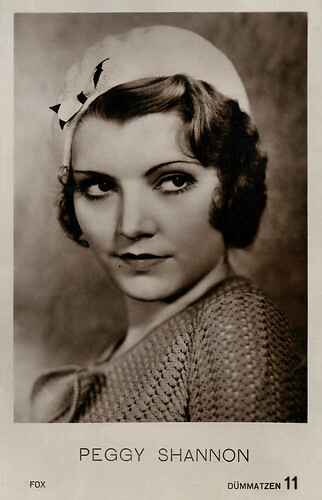
Spanish postcard by Dümmatzen, no. 11. Photo: Fox.
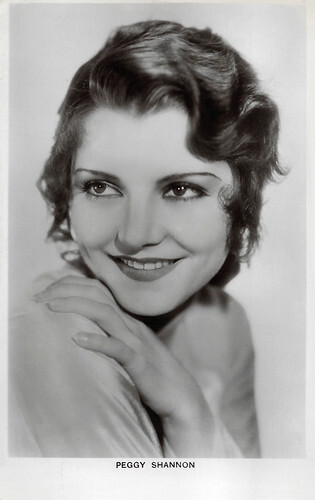
British postcard in the Picturegoer Series, London, no. 555.
The new Clara Bow
Peggy Shannon was born Winona Sammon in 1907, in Pine Bluff, Arkansas. Her parents were Edward Ham Sammon and Nannie M. Martin. She had a younger sister, Carol. She attended Catholic school where she became friends with child actress Madge Evans .
While visiting her aunt in New York sixteen-year-old Peggy was discovered by producer Florenz Ziegfeld Jr. He hired her as a chorus girl in 'Ziegfeld Follies of 1923'. Peggy married actor Alan Davis in 1926. The following year, she starred on Broadway in Earl Carrol's 'What Anne Brought Home' production.
In 1931 she was offered a contract at Paramount Studios. Only two days after she arrived in Hollywood, Paramount's Bud Schulberg gave Peggy a leading role in The Secret Call (Stuart Walker, 1931) opposite Richard Arlen . The role was originally intended for Clara Bow, but when "the It Girl" suffered a nervous breakdown Peggy with her beautiful face and red hair, was promoted as "the new Clara Bow".
Although Peggy Shannon also starred in the films This Reckless Age (Frank Tuttle, 1932) alongside Charles 'Buddy' Rogers and Hotel Continental (Christy Cabanne, 1932), her career never really took off. Shannon sometimes worked 16-hour days (from 10 a.m. to 4 a.m. the next day) while shooting a film, and when shooting wrapped, rushed to begin another film. She occasionally worked on two separate films in one day.
Through films and publicity, Shannon became known as a fashion plate, wearing styles three months before they became popular. In 1932, she signed a new contract at Fox and became known as difficult and temperamental on the set and was rumoured to have had a drinking problem. In 1934, Shannon's contract was not renewed and she returned to New York City.
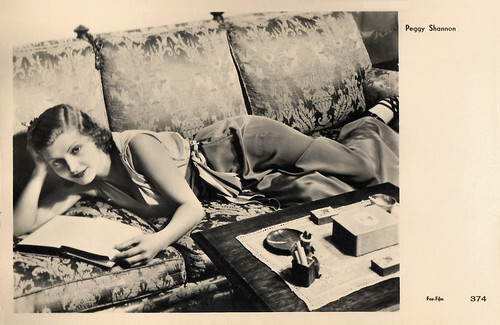
Dutch postcard by JosPe, Arnhem, no. 374. Photo: Fox-Film.
That red-headed girl
Peggy Shannon appeared in the Broadway play 'Page Miss Glory' (1934) as the girlfriend of a then-unknown Jimmy Stewart . She was fired from the play 'The Light Behind The Shadow' (1935). A press release claimed a tooth infection, though rumours claimed it was her drinking.
Peggy returned to Hollywood for the B-movie Youth on Parole (Phil Rosen, 1937). She found it harder to conceal her drinking. Fewer film roles were offered, and her drinking worsened. Her final films were Cafe Hostess (Sidney Salkow, 1940) starring Ann Dvorak and the Western Triple Justice (David Howard, 1940) with George O'Brien .
She divorced Alan Davis in 1940 and married cameraman Albert G. Roberts. After a fishing trip in 1941, her second husband and a fellow studio worker found Shannon slumped over the kitchen table in their North Hollywood apartment. She was dead, with her head down on her arms, a cigarette in her mouth, and an empty glass in her hand.
The actress had died from a heart attack at the young age of thirty-four. Her autopsy revealed that she had a serious liver ailment caused by her alcoholism. 19 days after Shannon's death, Roberts fatally shot himself right in the same chair in which she died. His suicide note read "I am very much in love with my wife, Peggy Shannon. In this spot she died, so in reverence to her, you will find me in the same spot."
Peggy Shannon is buried at Hollywood Forever Cemetery in Hollywood, California. The epitaph on her tombstone says "That Red-Headed Girl, Peggy Shannon".
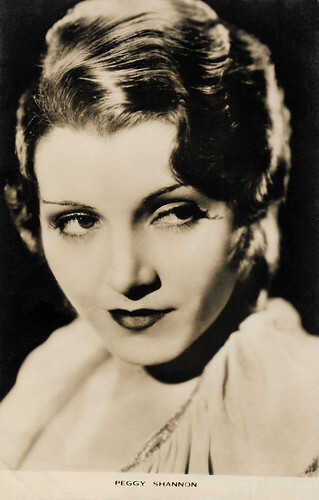
British postcard by Film Weekly, London.
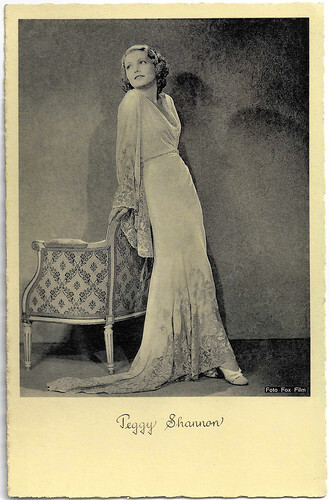
Vintage postcard, no. 23. Photo: Fox-Film.
Sources: (IMDb), Wikipedia and .

Spanish postcard by Dümmatzen, no. 11. Photo: Fox.

British postcard in the Picturegoer Series, London, no. 555.
The new Clara Bow
Peggy Shannon was born Winona Sammon in 1907, in Pine Bluff, Arkansas. Her parents were Edward Ham Sammon and Nannie M. Martin. She had a younger sister, Carol. She attended Catholic school where she became friends with child actress Madge Evans .
While visiting her aunt in New York sixteen-year-old Peggy was discovered by producer Florenz Ziegfeld Jr. He hired her as a chorus girl in 'Ziegfeld Follies of 1923'. Peggy married actor Alan Davis in 1926. The following year, she starred on Broadway in Earl Carrol's 'What Anne Brought Home' production.
In 1931 she was offered a contract at Paramount Studios. Only two days after she arrived in Hollywood, Paramount's Bud Schulberg gave Peggy a leading role in The Secret Call (Stuart Walker, 1931) opposite Richard Arlen . The role was originally intended for Clara Bow, but when "the It Girl" suffered a nervous breakdown Peggy with her beautiful face and red hair, was promoted as "the new Clara Bow".
Although Peggy Shannon also starred in the films This Reckless Age (Frank Tuttle, 1932) alongside Charles 'Buddy' Rogers and Hotel Continental (Christy Cabanne, 1932), her career never really took off. Shannon sometimes worked 16-hour days (from 10 a.m. to 4 a.m. the next day) while shooting a film, and when shooting wrapped, rushed to begin another film. She occasionally worked on two separate films in one day.
Through films and publicity, Shannon became known as a fashion plate, wearing styles three months before they became popular. In 1932, she signed a new contract at Fox and became known as difficult and temperamental on the set and was rumoured to have had a drinking problem. In 1934, Shannon's contract was not renewed and she returned to New York City.

Dutch postcard by JosPe, Arnhem, no. 374. Photo: Fox-Film.
That red-headed girl
Peggy Shannon appeared in the Broadway play 'Page Miss Glory' (1934) as the girlfriend of a then-unknown Jimmy Stewart . She was fired from the play 'The Light Behind The Shadow' (1935). A press release claimed a tooth infection, though rumours claimed it was her drinking.
Peggy returned to Hollywood for the B-movie Youth on Parole (Phil Rosen, 1937). She found it harder to conceal her drinking. Fewer film roles were offered, and her drinking worsened. Her final films were Cafe Hostess (Sidney Salkow, 1940) starring Ann Dvorak and the Western Triple Justice (David Howard, 1940) with George O'Brien .
She divorced Alan Davis in 1940 and married cameraman Albert G. Roberts. After a fishing trip in 1941, her second husband and a fellow studio worker found Shannon slumped over the kitchen table in their North Hollywood apartment. She was dead, with her head down on her arms, a cigarette in her mouth, and an empty glass in her hand.
The actress had died from a heart attack at the young age of thirty-four. Her autopsy revealed that she had a serious liver ailment caused by her alcoholism. 19 days after Shannon's death, Roberts fatally shot himself right in the same chair in which she died. His suicide note read "I am very much in love with my wife, Peggy Shannon. In this spot she died, so in reverence to her, you will find me in the same spot."
Peggy Shannon is buried at Hollywood Forever Cemetery in Hollywood, California. The epitaph on her tombstone says "That Red-Headed Girl, Peggy Shannon".

British postcard by Film Weekly, London.

Vintage postcard, no. 23. Photo: Fox-Film.
Sources: (IMDb), Wikipedia and .
Published on March 02, 2025 22:00
March 1, 2025
Marie Walcamp
Marie Walcamp (1894–1936) was one of Hollywood's most popular Serial Queens of the silent film era. She had her breakthrough at Universal with the serial The Werewolf. The blonde Ohio girl became an action heroine in many serials, including Westerns, in which she often appeared with Eddie Polo. All through the 1910s, she had a prosperous career at Universal such as in the very popular serial Liberty (1917), in which she had the lead. When the serials vogue was over by the early 1920s, so was Walcamp's career. In 1936 she committed suicide.
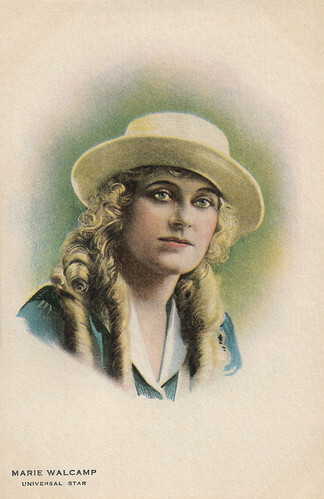
American postcard by Kline Poster Co. Inc., Phila. Image: Universal.
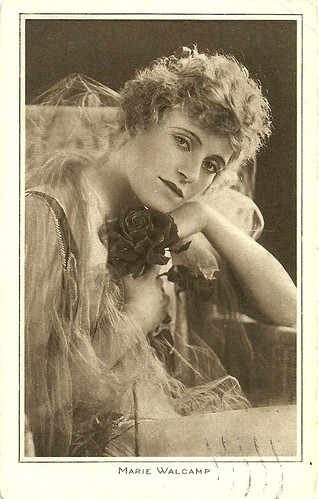
British postcard in the "Pictures" Portrait Gallery by Pictures Ltd., London, no. 125.
The first werewolf film
Marie Walcamp was born in Dennison, Ohio, in 1894. She was the daughter of Mary (née Mackel) and Arnold Walcamp. When she was five years old she won a local cake-walking contest. After her father's death, her family moved to Swissvale, Pennsylvania.
Marie dreamed of being on the stage so she started taking singing and dancing lessons. In 1912 she joined the Kolb and Dill stock company in San Francisco. After landing various roles in New York, she signed to Universal Studios in 1913.
At the age of 19, she was cast in the film The Werewolf (Henry McRae, 1913), considered the first werewolf film. She appeared in over 50 motion pictures, mostly shorts, over the next two years, although by 1916 the pace of her work in films began to decrease.
That year she still performed in no less than 13 productions, including the leading role in the Western serial Liberty (Jacques Jaccard, Henry MacRae, 1916) opposite Jack Holt and Eddie Polo . Marie played Liberty Horton, an American heiress, who is kidnapped by a Mexican rebel and ransomed to fund his rebellion. Liberty was the first purely Western serial ever made, although Western elements were included in earlier serials such as The Perils of Pauline (Louis J. Gasnier, Donald MacKenzie, 1914). The serial, which is now presumed to be lost, was one of the most popular of all time.
Marie Walcamp also battled a lion in the appropriately titled The Lion's Claws (Harry Harvey, Jacques Jaccard, 1918), her second chapterplay, and wore a deep scar for the rest of her life.
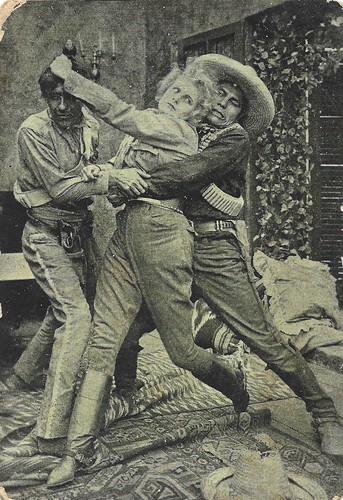
Spanish cromo by Chocolate Pi, Barcelona, no. 15. Photo: Distr. J. Verdaguer / Universal. Marie Walcamp in the Western serial Liberty (Henry MacRae, Jacques Jaccard, 1916). Here, Walcamp's Liberty is kidnapped.
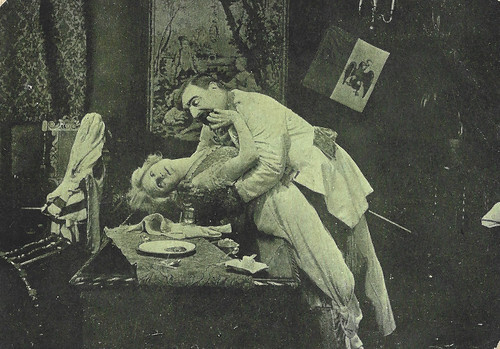
Spanish cromo by Chocolate Pi, Barcelona, no. 36. Photo: Distr. J. Verdaguer / Universal. Marie Walcamp with probably Raymond Nye as Pancho Lopez in the Western serial Liberty (Henry MacRae, Jacques Jaccard, 1916).
The dare-devil girl of the movies
Marie Walcamp was known for doing her own dangerous stunts, which earned her nicknames like 'The Daredevil of the Films' and 'The Dare-Devil Girl of the Movies'. She starred in the adventure serials The Red Ace and The Red Robe.
She also played roles in several Lois Weber films, including the social melodrama Hop - The Devil's Brew (Phillips Smalley, Lois Weber, 1916), the anti-abortion drama Where Are My Children? (Phillips Smalley, Lois Weber, 1916), and The Blot (Lois Weber, 1921).
Marie married actor Harland Tucker in 1919. They co-starred together in the action serial The Dragon's Net (Henry MacRae, 1920). The 1920s brought an end to women's dominance in all aspects of filmmaking, and Walcamp's film career was also waning as fewer serials were being made. Her final role was in 1927 as Alice Gage in the melodrama In a Moment of Temptation (Philip Carle, 1927).
Marie spent the next few years acting with a theatrical stock company. She made a screen test in 1933 for the serial The Perils Of Pauline but she didn't get the role. In 1934 she and Harland briefly separated. In 1936, Walcamp, suffering from depression, committed suicide by turning on the gas (or ingesting an overdose of painkillers - the sources differ) in her Los Angeles apartment while Harland Tucker was away on business.
She was only 42. In her will, Marie Walcamp asked that her ashes be scattered over the backlot at Universal Studios, where she had worked for so many years. Hans J. Wollstein at AllMovie : "Sadly, her only surviving films, the aforementioned Where Are My Children? and The Blot, are hardly representative of this pioneering action heroine whose popularity in the mid-1910s nearly rivalled serial queens Pearl White , Ruth Roland , and Helen Holmes."
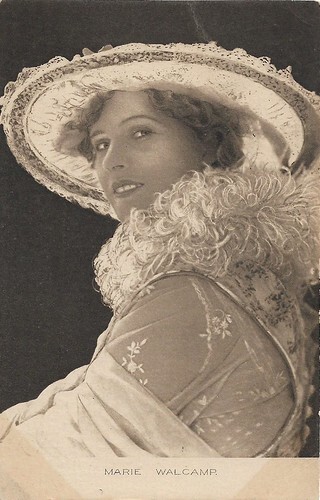
British postcard by The Transatlantic-Film Company Ltd. Transatlantic was the European subsidiary of Universal, with its main office in London.
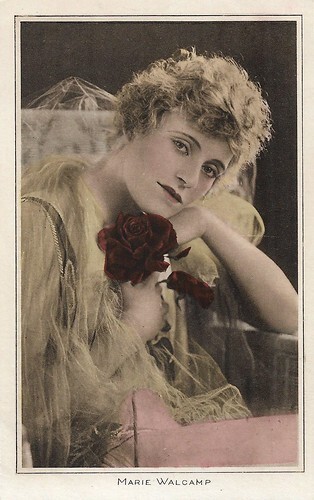
British postcard in the "Pictures" Portrait Gallery by Pictures Ltd., London, no. 125. Hand-coloured version.
Sources: Hans J. Wollstein (AllMovie - now defunct), Denny Jackson (IMDb), Classic Actresses, (now defunct) Wikipedia, and .

American postcard by Kline Poster Co. Inc., Phila. Image: Universal.

British postcard in the "Pictures" Portrait Gallery by Pictures Ltd., London, no. 125.
The first werewolf film
Marie Walcamp was born in Dennison, Ohio, in 1894. She was the daughter of Mary (née Mackel) and Arnold Walcamp. When she was five years old she won a local cake-walking contest. After her father's death, her family moved to Swissvale, Pennsylvania.
Marie dreamed of being on the stage so she started taking singing and dancing lessons. In 1912 she joined the Kolb and Dill stock company in San Francisco. After landing various roles in New York, she signed to Universal Studios in 1913.
At the age of 19, she was cast in the film The Werewolf (Henry McRae, 1913), considered the first werewolf film. She appeared in over 50 motion pictures, mostly shorts, over the next two years, although by 1916 the pace of her work in films began to decrease.
That year she still performed in no less than 13 productions, including the leading role in the Western serial Liberty (Jacques Jaccard, Henry MacRae, 1916) opposite Jack Holt and Eddie Polo . Marie played Liberty Horton, an American heiress, who is kidnapped by a Mexican rebel and ransomed to fund his rebellion. Liberty was the first purely Western serial ever made, although Western elements were included in earlier serials such as The Perils of Pauline (Louis J. Gasnier, Donald MacKenzie, 1914). The serial, which is now presumed to be lost, was one of the most popular of all time.
Marie Walcamp also battled a lion in the appropriately titled The Lion's Claws (Harry Harvey, Jacques Jaccard, 1918), her second chapterplay, and wore a deep scar for the rest of her life.

Spanish cromo by Chocolate Pi, Barcelona, no. 15. Photo: Distr. J. Verdaguer / Universal. Marie Walcamp in the Western serial Liberty (Henry MacRae, Jacques Jaccard, 1916). Here, Walcamp's Liberty is kidnapped.

Spanish cromo by Chocolate Pi, Barcelona, no. 36. Photo: Distr. J. Verdaguer / Universal. Marie Walcamp with probably Raymond Nye as Pancho Lopez in the Western serial Liberty (Henry MacRae, Jacques Jaccard, 1916).
The dare-devil girl of the movies
Marie Walcamp was known for doing her own dangerous stunts, which earned her nicknames like 'The Daredevil of the Films' and 'The Dare-Devil Girl of the Movies'. She starred in the adventure serials The Red Ace and The Red Robe.
She also played roles in several Lois Weber films, including the social melodrama Hop - The Devil's Brew (Phillips Smalley, Lois Weber, 1916), the anti-abortion drama Where Are My Children? (Phillips Smalley, Lois Weber, 1916), and The Blot (Lois Weber, 1921).
Marie married actor Harland Tucker in 1919. They co-starred together in the action serial The Dragon's Net (Henry MacRae, 1920). The 1920s brought an end to women's dominance in all aspects of filmmaking, and Walcamp's film career was also waning as fewer serials were being made. Her final role was in 1927 as Alice Gage in the melodrama In a Moment of Temptation (Philip Carle, 1927).
Marie spent the next few years acting with a theatrical stock company. She made a screen test in 1933 for the serial The Perils Of Pauline but she didn't get the role. In 1934 she and Harland briefly separated. In 1936, Walcamp, suffering from depression, committed suicide by turning on the gas (or ingesting an overdose of painkillers - the sources differ) in her Los Angeles apartment while Harland Tucker was away on business.
She was only 42. In her will, Marie Walcamp asked that her ashes be scattered over the backlot at Universal Studios, where she had worked for so many years. Hans J. Wollstein at AllMovie : "Sadly, her only surviving films, the aforementioned Where Are My Children? and The Blot, are hardly representative of this pioneering action heroine whose popularity in the mid-1910s nearly rivalled serial queens Pearl White , Ruth Roland , and Helen Holmes."

British postcard by The Transatlantic-Film Company Ltd. Transatlantic was the European subsidiary of Universal, with its main office in London.

British postcard in the "Pictures" Portrait Gallery by Pictures Ltd., London, no. 125. Hand-coloured version.
Sources: Hans J. Wollstein (AllMovie - now defunct), Denny Jackson (IMDb), Classic Actresses, (now defunct) Wikipedia, and .
Published on March 01, 2025 22:00
February 28, 2025
Pierre Perret
French singer and composer Pierre Perret (1934) is a legend of French chanson. His repertoire ranges from children's songs to comic, erotic and politically committed songs full of humour and tenderness. He is recognised as an outstanding poet and he also appeared in French films.
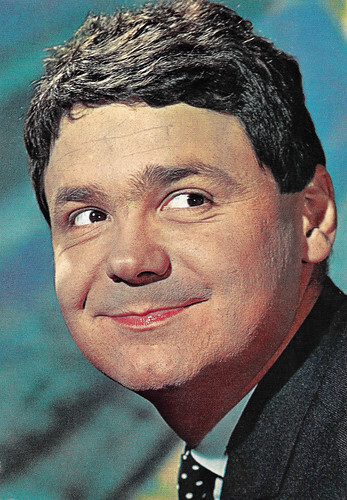
French postcard by Publistar Marseilles, no. 953. Photo: André Nisak, Paris / Vogue.
French postcard by PSG for Corvisart, Epinal, no. 1283. Photo: Disques Vogues.
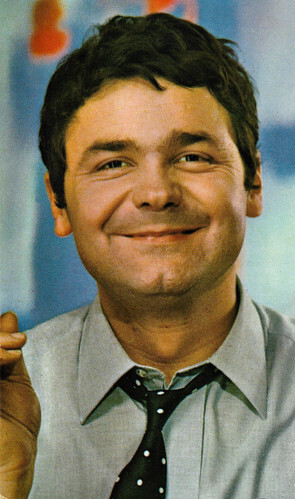
French postcard by PSG for Corvisart, Epinal, no. 1283. Photo: Disques Vogues.
In military prison during the final entrance exam to the Paris Conservatoire
Pierre Perret was born Pierre Max in 1934 in Castelsarrasin, Tarn-et-Garonne. His parents, Maurice and Claudia, ran the Café du Pont in Castelsarrasin, where he spent much of his childhood. Here he learned to use jargon and slang.
As a child, he appeared in two films, the crime drama Dernier atout/The Trump Card (Jacques Becker, 1942) starring Mireille Balin and Raymond Rouleau , and the drama Le carrefour des enfants perdus/Children of Chaos (Léo Joannon, 1944) starring René Dary .
At 14, he signed with the Conservatoire de Musique de Toulouse and the Toulouse Conservatoire of Dramatic Art. At 19 he won the first prize for saxophone. From 1953 to 1956, he did his military service and was unable to take the final entrance exam to the Paris Conservatoire, in Marcel Mule's class, as he was in military prison that day. He set up his first music group and performed at balls, family gatherings and other regional events.
In 1957, he was signed by producer Eddie Barclay and met his future wife, Simone Mazaltarim at Barclay's studio. His first single, 'Moi j'attends Adèle', was released that year. A recording at the Olympia for the radio programme Musicorama helped to put him on the map.
In 1958, Perret toured Parisian cabaret bars and crossed France and Africa as the opening act for the American group The Platters. He also played a small role in Les étoiles de midi/Stars at Noon (Jacques Ertaud, Marcel Ichac, 1958). In November of that year, a pleurisy forced him to take two years off recuperating in a sanatorium.
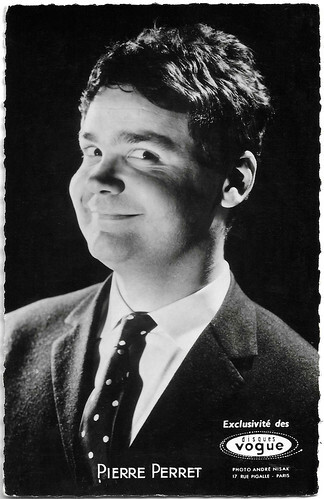
French promotion card by Disques Vogues. Photo: André Nisak, Paris.
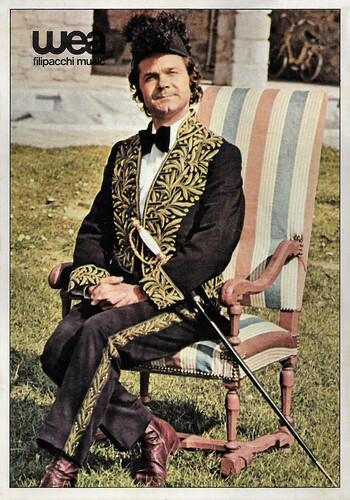
Italian collector card in the Hit Collection series by Panini. Photo: WEA / Filipacchi Music.
Le Zizi - His biggest hit
In 1960 Pierre Perret released 'Le Bonheur conjugal', but it was not a big enough success and Barclay did not renew his contract. He married Simone Mazaltarim, renamed Rebecca, in 1962, Their daughter Julie was born in 1963. He moved to Gennevilliers with his family, where he stayed for eight years.
Perret signed a six-year contract with Vogue and found a new impresario in Lucien Morisse. His first big hit came in 1964 with 'Le Tord-boyaux', which sold 75,000 copies. In 1966, the song 'Les Jolies Colonies de vacances' was a big hit, selling 200,000 copies. Perret enjoyed a string of successes and gave several concerts, opening for artists as diverse as Johnny Hallyday , Nana Mouskouri and the Rolling Stones on their first concert in France.
In 1969, he left Vogue and decided with his wife to self-produce by founding Editions Adèle, named after his first song. In the same year, he returned to the cinema. He played the title character in Claude Autant-Lara's comedy-drama Les Patates/Potatoes with Rufus, for which he also wrote the music.
The next year, he acted in the failure Un été sauvage/A Savage Summer (Marcel Camus, 1970) with Nino Ferrer and Katina Paxinou. In 1971 he played Judge Roy Bean in the Western parody Le Juge/Judge Roy Bean (Jean Girault, Federico Chentrens, 1971) with Silvia Monti and Robert Hossein .
1971 saw the release of 'La Cage aux oiseaux', which sold 300,000 copies. From 1974 onwards, Pierre Perret's records were arranged by Bernard Gérard, replacing Jean Claudric who had been orchestrating the singer since he joined Vogue. In 1975, he had his biggest hit with 'Le Zizi', which sold over 600,000 copies.
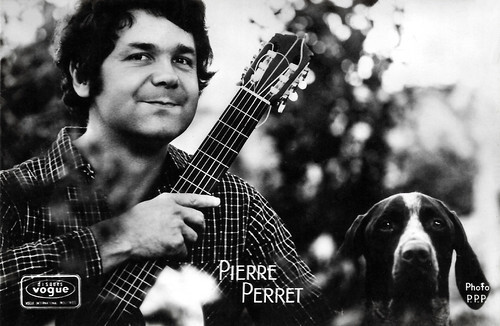
French promotion card by Disques Vogues. Photo: P.P.P.
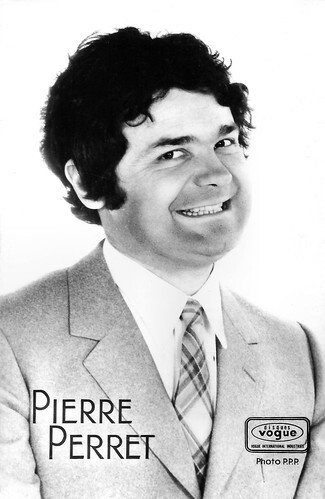
French promotion card by Disques Vogues. Photo: P.P.P.
A master of the subtleties of the French language and slang
Pierre Perret is a master of the subtleties of the French language and French slang. He even rewrote some of Jean de La Fontaine's fables. His songs are often cheeky, such as 'Le Zizi' (The Willy). He asks pertinent questions in a seemingly naive child's tone, with a malicious smile, but always with humanism and candour.
He also has written politically committed songs like 'La bête est revenue', 'La petite kurde', and 'Vert de Colère'. His song 'Lily' became a classic anti-racist song and won him the LICRA prize in 1978. Other politically committed songs followed, on abortion ('Elle attend son petit' in 1981), famine, excision and more generally the condition of women in Africa ('Riz pilé' in 1989), war ('La Petite Kurde' in 1992), ecology ('Vert de colère' in 1998) and the rise of fascism ('La Bête est revenue').
Released in 1998, this song against the Front National earned him many insulting letters. In 1995, Perret recorded a duet with Sophie Darel, 'Maître Pierre' for the album 'C'était les Années Bleues'. He participated in the committee for the simplification of the administrative language (COSLA). In 2020, Pierre Perret embarked on a major tour entitled 'Mes adieux provisoires', which was disrupted by the Covid pandemic, declaring that it would ‘surely’ be his last tour.
In 2023, he released a new album, 'Ma vieille carcasse', accompanied by the video 'Paris saccagé', criticising the policies of the Mayor of Paris, Anne Hidalgo. Alongside his singing activities, Pierre Perret has published several biographical works since his first book 'Adieu Monsieur Léautaud' (1972) was published. In 2009, Manuel Poirier made a film about Pierre Perret's childhood, based on his autobiography, 'Le Café du point'.
Perret himself could be seen in a bit role in the film Sous les étoiles de Paris/Under the Stars of Paris (Claud Drexel, 2020) starring Catherine Frot. He also wrote about another passion, gastronomy. Pierre Perret is still married to Simone Mazaltarim. They have three children but their daughter Julie died in 1995. The couple lives in Nangis, France.
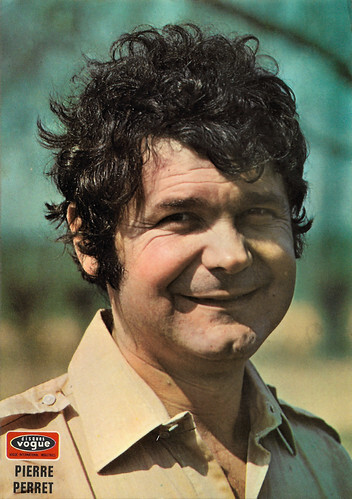
French promotion card by Disques Vogues.
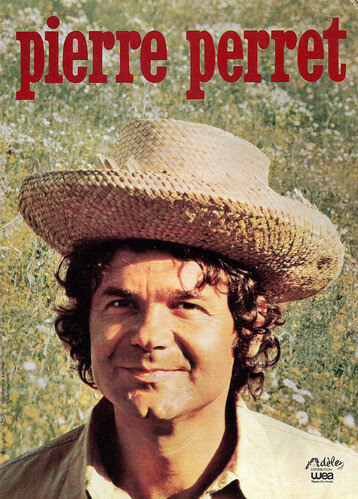
French promotion card by Imp. A Karcher, Aubervilliers for Adele / WEA. Photo: B. Saussin.
Sources: Wikipedia (French, German and English) and .

French postcard by Publistar Marseilles, no. 953. Photo: André Nisak, Paris / Vogue.
French postcard by PSG for Corvisart, Epinal, no. 1283. Photo: Disques Vogues.

French postcard by PSG for Corvisart, Epinal, no. 1283. Photo: Disques Vogues.
In military prison during the final entrance exam to the Paris Conservatoire
Pierre Perret was born Pierre Max in 1934 in Castelsarrasin, Tarn-et-Garonne. His parents, Maurice and Claudia, ran the Café du Pont in Castelsarrasin, where he spent much of his childhood. Here he learned to use jargon and slang.
As a child, he appeared in two films, the crime drama Dernier atout/The Trump Card (Jacques Becker, 1942) starring Mireille Balin and Raymond Rouleau , and the drama Le carrefour des enfants perdus/Children of Chaos (Léo Joannon, 1944) starring René Dary .
At 14, he signed with the Conservatoire de Musique de Toulouse and the Toulouse Conservatoire of Dramatic Art. At 19 he won the first prize for saxophone. From 1953 to 1956, he did his military service and was unable to take the final entrance exam to the Paris Conservatoire, in Marcel Mule's class, as he was in military prison that day. He set up his first music group and performed at balls, family gatherings and other regional events.
In 1957, he was signed by producer Eddie Barclay and met his future wife, Simone Mazaltarim at Barclay's studio. His first single, 'Moi j'attends Adèle', was released that year. A recording at the Olympia for the radio programme Musicorama helped to put him on the map.
In 1958, Perret toured Parisian cabaret bars and crossed France and Africa as the opening act for the American group The Platters. He also played a small role in Les étoiles de midi/Stars at Noon (Jacques Ertaud, Marcel Ichac, 1958). In November of that year, a pleurisy forced him to take two years off recuperating in a sanatorium.

French promotion card by Disques Vogues. Photo: André Nisak, Paris.

Italian collector card in the Hit Collection series by Panini. Photo: WEA / Filipacchi Music.
Le Zizi - His biggest hit
In 1960 Pierre Perret released 'Le Bonheur conjugal', but it was not a big enough success and Barclay did not renew his contract. He married Simone Mazaltarim, renamed Rebecca, in 1962, Their daughter Julie was born in 1963. He moved to Gennevilliers with his family, where he stayed for eight years.
Perret signed a six-year contract with Vogue and found a new impresario in Lucien Morisse. His first big hit came in 1964 with 'Le Tord-boyaux', which sold 75,000 copies. In 1966, the song 'Les Jolies Colonies de vacances' was a big hit, selling 200,000 copies. Perret enjoyed a string of successes and gave several concerts, opening for artists as diverse as Johnny Hallyday , Nana Mouskouri and the Rolling Stones on their first concert in France.
In 1969, he left Vogue and decided with his wife to self-produce by founding Editions Adèle, named after his first song. In the same year, he returned to the cinema. He played the title character in Claude Autant-Lara's comedy-drama Les Patates/Potatoes with Rufus, for which he also wrote the music.
The next year, he acted in the failure Un été sauvage/A Savage Summer (Marcel Camus, 1970) with Nino Ferrer and Katina Paxinou. In 1971 he played Judge Roy Bean in the Western parody Le Juge/Judge Roy Bean (Jean Girault, Federico Chentrens, 1971) with Silvia Monti and Robert Hossein .
1971 saw the release of 'La Cage aux oiseaux', which sold 300,000 copies. From 1974 onwards, Pierre Perret's records were arranged by Bernard Gérard, replacing Jean Claudric who had been orchestrating the singer since he joined Vogue. In 1975, he had his biggest hit with 'Le Zizi', which sold over 600,000 copies.

French promotion card by Disques Vogues. Photo: P.P.P.

French promotion card by Disques Vogues. Photo: P.P.P.
A master of the subtleties of the French language and slang
Pierre Perret is a master of the subtleties of the French language and French slang. He even rewrote some of Jean de La Fontaine's fables. His songs are often cheeky, such as 'Le Zizi' (The Willy). He asks pertinent questions in a seemingly naive child's tone, with a malicious smile, but always with humanism and candour.
He also has written politically committed songs like 'La bête est revenue', 'La petite kurde', and 'Vert de Colère'. His song 'Lily' became a classic anti-racist song and won him the LICRA prize in 1978. Other politically committed songs followed, on abortion ('Elle attend son petit' in 1981), famine, excision and more generally the condition of women in Africa ('Riz pilé' in 1989), war ('La Petite Kurde' in 1992), ecology ('Vert de colère' in 1998) and the rise of fascism ('La Bête est revenue').
Released in 1998, this song against the Front National earned him many insulting letters. In 1995, Perret recorded a duet with Sophie Darel, 'Maître Pierre' for the album 'C'était les Années Bleues'. He participated in the committee for the simplification of the administrative language (COSLA). In 2020, Pierre Perret embarked on a major tour entitled 'Mes adieux provisoires', which was disrupted by the Covid pandemic, declaring that it would ‘surely’ be his last tour.
In 2023, he released a new album, 'Ma vieille carcasse', accompanied by the video 'Paris saccagé', criticising the policies of the Mayor of Paris, Anne Hidalgo. Alongside his singing activities, Pierre Perret has published several biographical works since his first book 'Adieu Monsieur Léautaud' (1972) was published. In 2009, Manuel Poirier made a film about Pierre Perret's childhood, based on his autobiography, 'Le Café du point'.
Perret himself could be seen in a bit role in the film Sous les étoiles de Paris/Under the Stars of Paris (Claud Drexel, 2020) starring Catherine Frot. He also wrote about another passion, gastronomy. Pierre Perret is still married to Simone Mazaltarim. They have three children but their daughter Julie died in 1995. The couple lives in Nangis, France.

French promotion card by Disques Vogues.

French promotion card by Imp. A Karcher, Aubervilliers for Adele / WEA. Photo: B. Saussin.
Sources: Wikipedia (French, German and English) and .
Published on February 28, 2025 22:00
February 27, 2025
Gene Hackman (1930-2025)
On 26 February 2025, American actor Gene Hackman (1930-2025) and his wife, the pianist Betsy Arakawa, were found dead in their home in Santa Fe. The cause is not yet made public. Hackman became a Hollywood star in the 1970s with such films as The French Connection (1971), The Conversation (1974) and Bite the Bullet (1975). He won Oscars for The French Connection (1971) and for Clint Eastwood's Western Unforgiven (1992), making it the fifth time he was nominated. Gene Hackman was 95.
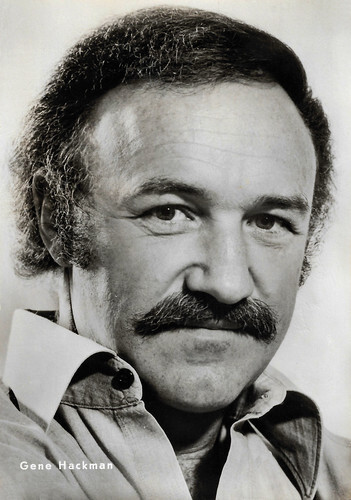
East German postcard by VEB Progress Film-Verleih, Berlin, no. 73/77.
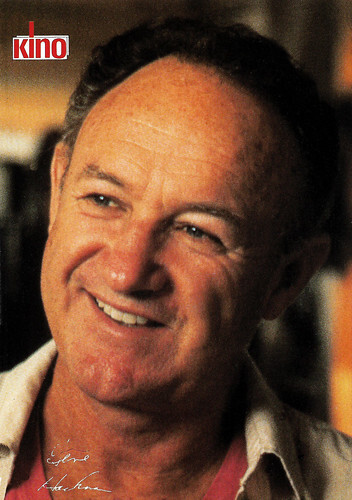
West German collectors card by Kino.
Drop-out
Eugene Allen Hackman was born in San Bernardino, California, in 1930. He was the son of Anna Lyda Elizabeth (Gray) and Eugene Ezra Hackman, who operated a newspaper printing press. After several moves, his family settled in Danville, Illinois. As a child, he had to spend much time looking after his grandmother while his parents were at work.
Hackman was about 14 years old when his father walked out of the family, and Gene left home at sixteen for a hitch with the US Marines. Moving to New York after being discharged, he worked in several menial jobs before studying journalism and television production on the G.I. Bill at the University of Illinois.
Hackman would be over 30 years old when he finally decided to take his chance at acting by enrolling at the Pasadena Playhouse in California. Legend says that after flunking out of the Pasadena Playhouse after 3 months and moving to New York City with fellow drop-out Dustin Hoffman , Hackman worked at the Howard Johnson's restaurant in Times Square as a doorman. One day, a Pasadena Playhouse acting teacher whom Hackman hated walked by him, stopped, and told him that he had been right, that Hackman would never amount to anything.
Hackman worked in summer stock and off-Broadway. In 1964, he was cast as the young suitor in the Broadway play 'Any Wednesday'. This role would lead to him being cast in the small role of Norman in Lilith (Robert Rossen, 1964), starring Warren Beatty and Jean Seberg .
When Beatty was casting for Bonnie and Clyde (Arthur Penn, 1967), he cast Hackman as Buck Barrow, Clyde Barrow's brother. That role earned Hackman a nomination for the Academy Award for Best Supporting Actor, an award for which he would again be nominated in I Never Sang for My Father (Gilbert Cates, 1970).

Canadian postcard by Canadian Postcard, no. A-18. Photo: Columbia TriStar. Gene Hackman, Estelle Parsons, Warren Beatty , Faye Dunaway and Michael J. Pollard in Bonnie and Clyde (Arthur Penn, 1967).
A star at 40
In 1972, Gene Hackman won the Oscar for his role as Detective Jimmy "Popeye" Doyle in The French Connection (William Friedkin, 1971). At 40 years old, Hackman was a Hollywood star. He has stated that his performance in Scarecrow (Jerry Schatzberg, 1973) opposite Al Pacino is his personal favourite. The film was critically acclaimed but tanked at the box office.
He based his role in The Conversation (Francis Ford Coppola, 1974) on one of his uncles and a fellow Marine he had known well. Other successes were the crime drama Night Moves (Arthur Penn, 1975), the Western Bite the Bullit (Richard Brooks, 1975) about a 700-mile horse race and the sequel French Connection II (John Frankenheimer, 1975).
Hackman was a versatile actor who played the blind man in the comedy Young Frankenstein (Mel Brooks, 1974) and the evil Lex Luthor in Superman (Richard Donner, 1978) and Superman II (Richard Donner, Richard Lester, 1980).
In 1983, he scored a hit with Under Fire (Roger Spottiswoode, 1983) starring Nick Nolte. More successes followed, such as his high school basketball coach role in Hoosiers (David Anspaugh, 1986) with Barbara Hershey.
It culminated in 1988 when he starred in five films, including Another Woman (Woody Allen, 1988) with Gena Rowlands and Mississippi Burning (Alan Parker, 1988) with Willem Dafoe. For the latter film, he received another Oscar nomination.
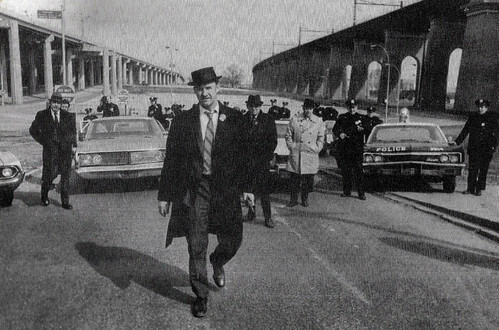
Belgian postcard by Raider Bounty / Joepie. Gene Hackman in The French Connection (William Friedkin, 1971).
Not tired of Westerns at all
After initially turning down the role of the sadistic sheriff "Little" Bill Daggett in Clint Eastwood 's Unforgiven (1992), Gene Hackman finally accepted it, as its different slant on the Western interested him. For his performance, he won the Oscar and Golden Globe and decided that he wasn't tired of Westerns after all. He appeared in Geronimo: An American Legend (Walter Hill, 1993), Wyatt Earp (Lawrence Kasdan, 1994), and The Quick and the Dead (Sam Raimi, 1995) with Sharon Stone . He appeared in three films adapted from novels by John Grisham: The Firm (Sydney Pollack, 1993) with Tom Cruise , as convict Sam Cayhall on death row in The Chamber (James Foley, 1996) and as jury consultant Rankin Fitch in Runaway Jury (Gary Fleder, 2003) with Dustin Hoffman .
Hackman played film director Harry Zimm in the comedy-drama Get Shorty (Barry Sonnenfeld, 1995) with John Travolta . He also played a submarine Captain on the edge of nuclear destruction in Crimson Tide (Tony Scott, 1995) alongside Denzel Washington, a conservative Senator in a dragqueen club in The Birdcage (Mike Nichols, 1996) and a doctor who puts his work above people in Extreme Measures (Michael Apted, 1996).
He played the president of the US in Absolute Power (Clint Eastwood, 1997) and co-starred with Will Smith in the political thriller Enemy of the State (Tony Scott, 1998), his character reminiscent of the one he had portrayed in The Conversation. One of the most sustaining actors of all time, he still averaged two films a year in his 70s, having starred in six in 2001 alone, including Wes Anderson's The Royal Tenenbaums (2001). However, this changed in 2004, when he last acted in Welcome to Mooseport (Donald Petrie, 2004).
In 2008, he announced his retirement from acting at the age of 78. In 2011, he released a novel, a violent Western, 'Payback at Morning Peak'. Another novel, 'Pursuit', a police thriller, followed in 2013. Gene Hackman was married for 30 years to Faye Maltese, with whom he has one son and two daughters: Christopher Allen, Elizabeth Jean, and Leslie Anne Hackman. The couple divorced in 1986. In 1991, Hackman married again, to classical pianist Betsy Arakawa.
On 26 February 2025, Gene Hackman, his wife, and one of their three dogs were found dead at their home in Santa Fe, New Mexico. Their bodies were found by maintenance workers who investigated after they found the front door of the property open. Hackman was found in the mudroom and Arakawa was found in the bathroom, and both showed signs of decay. Near Arakawa was an open prescription pill bottle with loose pills strewn about the floor. The next day, Santa Fe County Sheriff's Department said there were no significant signs of foul play, but did not initially provide time or cause of death. Later the same day, the sheriff told news media that the couple appeared to have died at least a day before their bodies were discovered. Police obtained a search warrant for the home to examine its "furniture, walls, plumbing equipment, [and] gas lines", attesting that while there were "no obvious signs of a gas leak" on first examination, the couple's sudden deaths were consistent with one, necessitating a "thorough investigation". An autopsy will be conducted on the bodies to determine cause and time of death.
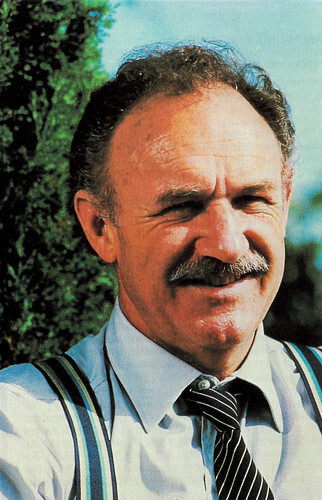
Dutch collectors card. Gene Hackman in Misunderstood (Jerry Schatzberg, 1984).
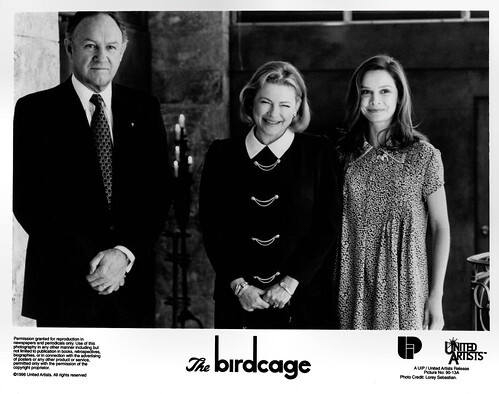
Vintage press photo by UIP / United Artists, no. 90/13A. Photo: Lorey Sebastian. Gene Hackman, Dianne Wiest and Calista Flockhart in The Birdcage (Mike Nichols, 1996).
Sources: (IMDb), Wikipedia (Dutch, German and English) and .

East German postcard by VEB Progress Film-Verleih, Berlin, no. 73/77.

West German collectors card by Kino.
Drop-out
Eugene Allen Hackman was born in San Bernardino, California, in 1930. He was the son of Anna Lyda Elizabeth (Gray) and Eugene Ezra Hackman, who operated a newspaper printing press. After several moves, his family settled in Danville, Illinois. As a child, he had to spend much time looking after his grandmother while his parents were at work.
Hackman was about 14 years old when his father walked out of the family, and Gene left home at sixteen for a hitch with the US Marines. Moving to New York after being discharged, he worked in several menial jobs before studying journalism and television production on the G.I. Bill at the University of Illinois.
Hackman would be over 30 years old when he finally decided to take his chance at acting by enrolling at the Pasadena Playhouse in California. Legend says that after flunking out of the Pasadena Playhouse after 3 months and moving to New York City with fellow drop-out Dustin Hoffman , Hackman worked at the Howard Johnson's restaurant in Times Square as a doorman. One day, a Pasadena Playhouse acting teacher whom Hackman hated walked by him, stopped, and told him that he had been right, that Hackman would never amount to anything.
Hackman worked in summer stock and off-Broadway. In 1964, he was cast as the young suitor in the Broadway play 'Any Wednesday'. This role would lead to him being cast in the small role of Norman in Lilith (Robert Rossen, 1964), starring Warren Beatty and Jean Seberg .
When Beatty was casting for Bonnie and Clyde (Arthur Penn, 1967), he cast Hackman as Buck Barrow, Clyde Barrow's brother. That role earned Hackman a nomination for the Academy Award for Best Supporting Actor, an award for which he would again be nominated in I Never Sang for My Father (Gilbert Cates, 1970).

Canadian postcard by Canadian Postcard, no. A-18. Photo: Columbia TriStar. Gene Hackman, Estelle Parsons, Warren Beatty , Faye Dunaway and Michael J. Pollard in Bonnie and Clyde (Arthur Penn, 1967).
A star at 40
In 1972, Gene Hackman won the Oscar for his role as Detective Jimmy "Popeye" Doyle in The French Connection (William Friedkin, 1971). At 40 years old, Hackman was a Hollywood star. He has stated that his performance in Scarecrow (Jerry Schatzberg, 1973) opposite Al Pacino is his personal favourite. The film was critically acclaimed but tanked at the box office.
He based his role in The Conversation (Francis Ford Coppola, 1974) on one of his uncles and a fellow Marine he had known well. Other successes were the crime drama Night Moves (Arthur Penn, 1975), the Western Bite the Bullit (Richard Brooks, 1975) about a 700-mile horse race and the sequel French Connection II (John Frankenheimer, 1975).
Hackman was a versatile actor who played the blind man in the comedy Young Frankenstein (Mel Brooks, 1974) and the evil Lex Luthor in Superman (Richard Donner, 1978) and Superman II (Richard Donner, Richard Lester, 1980).
In 1983, he scored a hit with Under Fire (Roger Spottiswoode, 1983) starring Nick Nolte. More successes followed, such as his high school basketball coach role in Hoosiers (David Anspaugh, 1986) with Barbara Hershey.
It culminated in 1988 when he starred in five films, including Another Woman (Woody Allen, 1988) with Gena Rowlands and Mississippi Burning (Alan Parker, 1988) with Willem Dafoe. For the latter film, he received another Oscar nomination.

Belgian postcard by Raider Bounty / Joepie. Gene Hackman in The French Connection (William Friedkin, 1971).
Not tired of Westerns at all
After initially turning down the role of the sadistic sheriff "Little" Bill Daggett in Clint Eastwood 's Unforgiven (1992), Gene Hackman finally accepted it, as its different slant on the Western interested him. For his performance, he won the Oscar and Golden Globe and decided that he wasn't tired of Westerns after all. He appeared in Geronimo: An American Legend (Walter Hill, 1993), Wyatt Earp (Lawrence Kasdan, 1994), and The Quick and the Dead (Sam Raimi, 1995) with Sharon Stone . He appeared in three films adapted from novels by John Grisham: The Firm (Sydney Pollack, 1993) with Tom Cruise , as convict Sam Cayhall on death row in The Chamber (James Foley, 1996) and as jury consultant Rankin Fitch in Runaway Jury (Gary Fleder, 2003) with Dustin Hoffman .
Hackman played film director Harry Zimm in the comedy-drama Get Shorty (Barry Sonnenfeld, 1995) with John Travolta . He also played a submarine Captain on the edge of nuclear destruction in Crimson Tide (Tony Scott, 1995) alongside Denzel Washington, a conservative Senator in a dragqueen club in The Birdcage (Mike Nichols, 1996) and a doctor who puts his work above people in Extreme Measures (Michael Apted, 1996).
He played the president of the US in Absolute Power (Clint Eastwood, 1997) and co-starred with Will Smith in the political thriller Enemy of the State (Tony Scott, 1998), his character reminiscent of the one he had portrayed in The Conversation. One of the most sustaining actors of all time, he still averaged two films a year in his 70s, having starred in six in 2001 alone, including Wes Anderson's The Royal Tenenbaums (2001). However, this changed in 2004, when he last acted in Welcome to Mooseport (Donald Petrie, 2004).
In 2008, he announced his retirement from acting at the age of 78. In 2011, he released a novel, a violent Western, 'Payback at Morning Peak'. Another novel, 'Pursuit', a police thriller, followed in 2013. Gene Hackman was married for 30 years to Faye Maltese, with whom he has one son and two daughters: Christopher Allen, Elizabeth Jean, and Leslie Anne Hackman. The couple divorced in 1986. In 1991, Hackman married again, to classical pianist Betsy Arakawa.
On 26 February 2025, Gene Hackman, his wife, and one of their three dogs were found dead at their home in Santa Fe, New Mexico. Their bodies were found by maintenance workers who investigated after they found the front door of the property open. Hackman was found in the mudroom and Arakawa was found in the bathroom, and both showed signs of decay. Near Arakawa was an open prescription pill bottle with loose pills strewn about the floor. The next day, Santa Fe County Sheriff's Department said there were no significant signs of foul play, but did not initially provide time or cause of death. Later the same day, the sheriff told news media that the couple appeared to have died at least a day before their bodies were discovered. Police obtained a search warrant for the home to examine its "furniture, walls, plumbing equipment, [and] gas lines", attesting that while there were "no obvious signs of a gas leak" on first examination, the couple's sudden deaths were consistent with one, necessitating a "thorough investigation". An autopsy will be conducted on the bodies to determine cause and time of death.

Dutch collectors card. Gene Hackman in Misunderstood (Jerry Schatzberg, 1984).

Vintage press photo by UIP / United Artists, no. 90/13A. Photo: Lorey Sebastian. Gene Hackman, Dianne Wiest and Calista Flockhart in The Birdcage (Mike Nichols, 1996).
Sources: (IMDb), Wikipedia (Dutch, German and English) and .
Published on February 27, 2025 22:00
February 26, 2025
Paul Westermeier
German actor Paul Westermeier (1892-1972) had an impressive filmography with more than 200 titles. He usually played the somewhat grumpy man next door, often with a Berlin flair. Westermeier never achieved the star status of some of his Ufa colleagues and seems to have fallen into oblivion today.
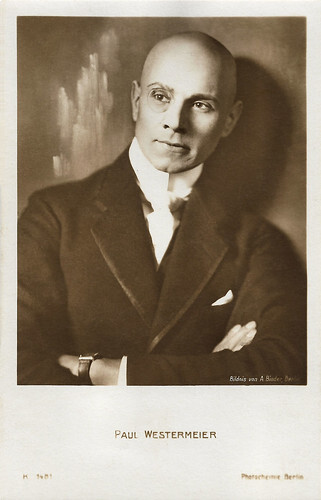
German postcard by Photochemie, Berlin, no. K 1481. Photo: A. (Alex) Binder, Berlin.
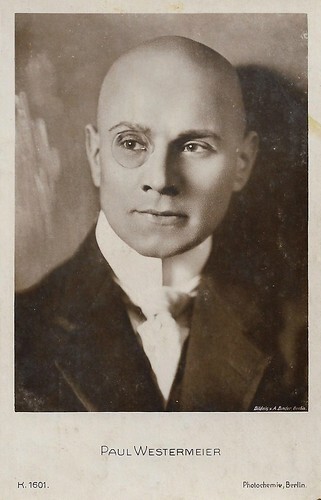
German postcard by Photochemie, Berlin, no. K. 1601. Photo: A. (Alex) Binder, Berlin.
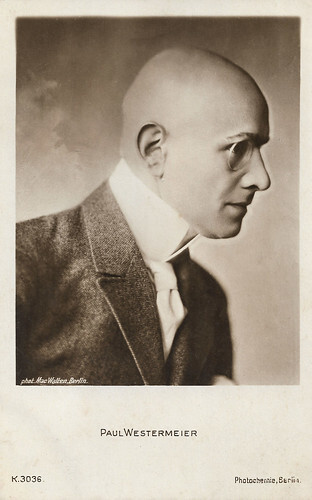
German postcard by Photochemie, Berlin, no. K 3036. Photo: Mac Walten, Berlin.
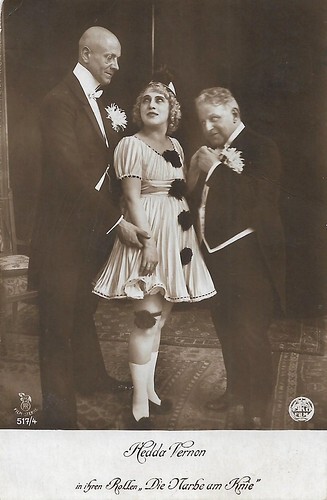
German postcard by Rotophot in the Film-Sterne series, no. 517/4. Photo: Eiko-Film. Hedda Vernon , Paul Westermeier and probably Ferry Sikla in Die Narbe am Knie (Hubert Moest, 1917).
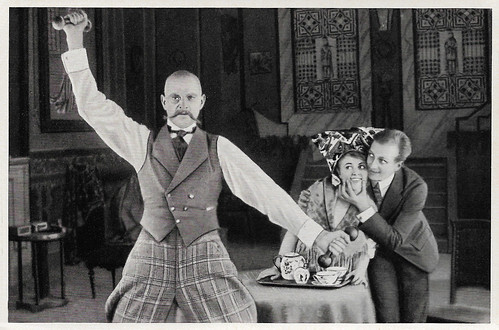
German collectors card by Ross Verlag in the series Vom Werden Deutscher Filmkunst - Der Stumme Film, picture no. 38, group 43. Photo: Paul Westermeier, Hanne Brinkmann and Hans Albers in Baroneßchen auf Strafurlaub/Little Baroness on Punishment Holiday (Otto Rippert, 1917). Caption: "Paul Westermeier 'hantelt', Hans Albers darf in einer kleinen Nebenrolle Hanne Brinkmann in die Wange kneifen". (Paul Westermeier 'works out', Hans Albers - in a small secondary role - is allowed to pinch Hanne Brinkmann in the cheek.)
Well-known star in operettas and revues
Paul Westermeier was born Paul Ernst Westemeier in 1892 in Berlin. He was the son of the labourer (or civil servant - the sources differ) Engelbert Westemeier and his wife Luise, née Nagora. In his youth, he tried his hand as a clown and fire-eater for the circus Schumann and played in the school theatre club.
He left school before his A-levels and took acting lessons with Moritz Zeisler at the Königliches Schauspielhaus (the Royal Theatre) and Maria Seebach at her acting school. He made his debut at the Königliches Schauspielhaus at the age of 17. In 1909 he received his first engagement as jeune premier in Stralsund.
In the next two years, he worked in Plauen and Magdeburg. In 1911 he moved to Hamburg, and the following year to Bremen, where he appeared as Romeo in 'Romeo and Juliet'. From 1913, he performed on Berlin stages, particularly at the Metropol-Theater, the Theater im Admiralspalast and the Thalia-Theater.
Westermeier also appeared in silent films. He made his film debut in Sondi hat Pech/Sondi has Bad Luck (Ludwig Czerny, Emil Sondermann, 1915) with Emil Sondermann as Sondi. Soon followed more silent films such as the crime film Die Hochzeit im Excentricclub/Wedding in the Eccentric Club (Joe May, 1917) starring Harry Liedtke as detective Joe Deebs, and the comedy Agnes Arnau und ihre drei Freier/Agnes Arnau and Her Three Suitors (Rudolf Biebrach, 1918) starring Henny Porten and Hermann Thimig .
He became a well-known star in operettas and revues during the 1920s. He appeared in operettas such as 'Maske in Blau' (Mask in Blue), 'Die lustige Witwe'(The Merry Widow), 'Hochzeitsnacht im Paradies' (Wedding Night in Paradise) and as Lothar in 'Ein Walzertraum' (A Waltz Dream) as well as Giesecke in 'Im weißen Rößl' (The White Horse Inn). Several times he was Lotte Werkmeister's partner.
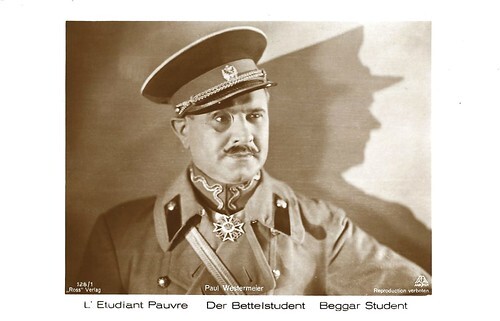
German postcard by Ross Verlag, no. 128/1. Photo: Aafa Film. Paul Westermeier in Der Bettelstudent/The Beggar Student (Victor Janson, 1931). It is one of the many film adaptations of the eponymous operetta 'Der Bettelstudent' (1882) by Karl Millöcker. In 1927 there was for instance a silent version with Hans Junkermann as Colonel Ollendorf.
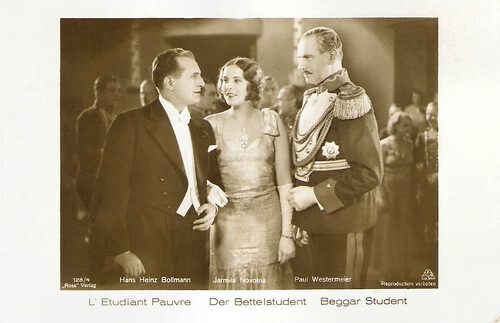
German postcard by Ross Verlag, no. 128/4. Photo: Aafa Film. Jarmila Novotná , Paul Westermeier and Hans Heinz Bollmann in Der Bettelstudent/The Beggar Student (Victor Janson, 1931).
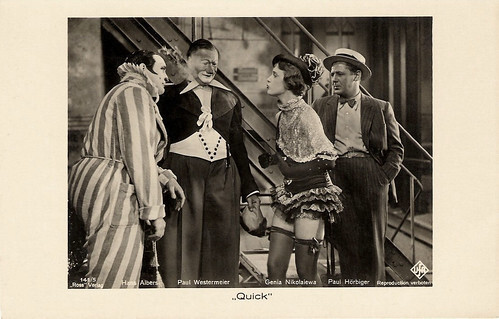
German postcard by Ross Verlag, no. 141/5, 1931-1932. Photo: Ufa. Hans Albers , Paul Hörbiger , Paul Westermeier and Genia Nikolaieva in Quick (Robert Siodmak, 1931).
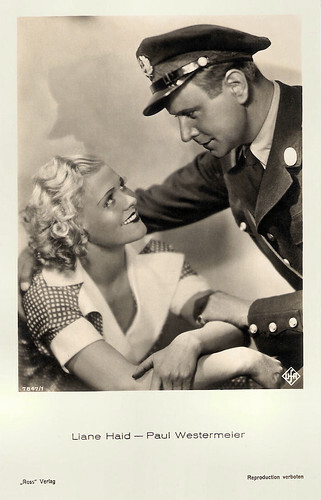
German postcard by Ross Verlag, no. 7847/1, 1932-1933. Photo: Ufa. Liane Haid and Paul Westermeier in Der Stern von Valencia/The Star of Valencia (Alfred Zeisler, 1933).
The grumpy Berliner
During the 1920s, Paul Westermeier gradually became a comedian. He appeared as an important supporting actor in such films as Der dumme August des Zirkus Romanelli/Circus Romanelli (Georg Jacoby, 1926) starring Reinhold Schünzel , and Eine tolle Nacht/A Crazy Night (Richard Oswald, 1927) starring Ossi Oswalda and Harry Liedtke .
He became a typical bit-part actor in the sound era, appearing in over 200 films. He usually played the somewhat grumpy man next door, often with a Berlin flair, such as the innkeeper Hentschke in Berlin-Alexanderplatz (Phil Jutzi, 1931) starring Heinrich George , and as Clock in the comedy Quick (Robert Siodmak, 1932), starring Lilian Harvey . He also played the radio operator Jaul in the submarine drama Morgenrot/Dawn (Gustav Ucicky, 1933) and had an important part in the (lost) comedy April, April! (Detlef Sierck, 1934).
In the later 1930s he acted in he crime drama Sein bester Freund/His Best Friend (Harry Piel, 1937), and Der grüne Kaiser (Paul Mundorf, 1939). During the war, he appeared in minor roles in several Propaganda films such as Die Rothschilds/The Rotschilds (Erich Waschneck, 1940), Blutsbrüderschaft/Blood Brotherhood (Philipp Lothar Mayring, 1941) and Andreas Schlüter (Herbert Maisch, 1942). In 1944, he was on the Gottbegnadeten-Liste (List of Godsent) by the Reich Ministry for Popular Enlightenment and Propaganda. That year he had the lead in Die Familie Buchholz/The Buchholz Family (Carl Froehlich, 1944) with Henny Porten .
After the Second World War, he was able to continue his career without any problems. He was even more strongly committed to the permanent role of the grumpy Berliner, for example as the captain and antagonist of Heinz Erhardt as a triplet, in Drillinge an Bord/Triplets on Board (Hans Müller, 1959). Sometimes, he played uncharacteristically quiet roles such as the driver in Sauerbruch - Das war mein Leben/The Life of Surgeon Sauerbruch (Rolf Hansen, 1954) with Ewald Balser and in Des Teufels General/The Devil's General (Helmut Käutner, 1955) starring Curd Jürgens .
Paul Westermeier continued to act on Berlin stages and also worked as a radio play narrator. He was married to former actress and singer Lotte Dobischinsky since 1936. In 1967, he received the Filmband in Gold for many years of outstanding work in German film. In 1972, Westermeier died in Berlin, at the age of 80. His grave is located in the Schöneberg III cemetery in Berlin.
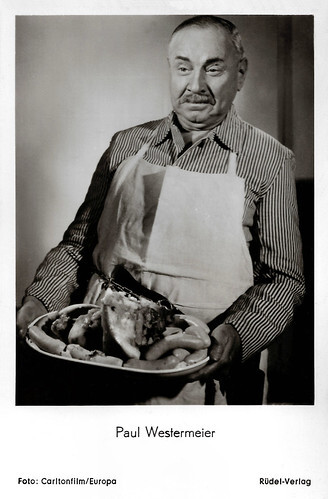
West German postcard by Rüdel Verlag, Hamburg-Bergedorf. Photo: Carltonfilm / Europa. Paul Westermeier in Die verschwundene Miniatur / The Miniature that Disappeared (Carl-Heinz Schroth, 1954).
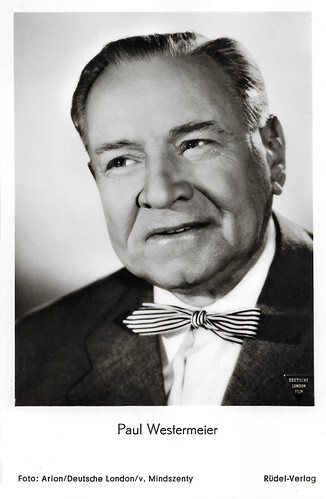
West German postcard by Rüdel Verlag, Hamburg-Bergedorf, no. 900. Photo: Arion / Deutsche London / Von Mindszenty. Paul Westermeier in Geld aus der Luft / Money from the Air (Géza von Cziffra, 1954).
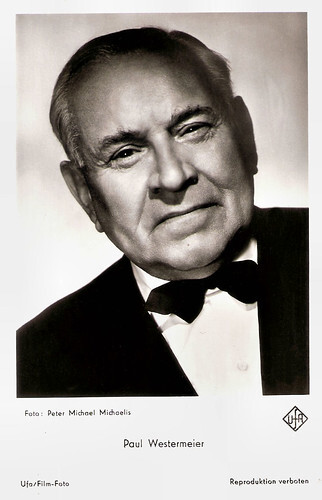
West German postcard by Ufa/Film-Foto, Berlin-Tempelhof, no. P.W. 2. Photo: Peter Michael Michaelis / UFA.
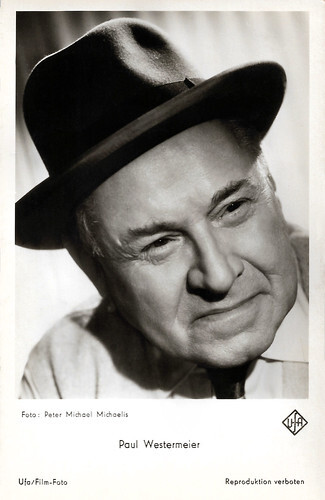
West German postcard by Ufa/Film-Foto, Berlin-Tempelhof, no. P.W. 3. Photo: Peter Michael Michaelis / Ufa.
Sources: Stephanie D'heil (Steffi-Line - German), Thomas Staedeli (Cyranos), Wikipedia (German and English) and .

German postcard by Photochemie, Berlin, no. K 1481. Photo: A. (Alex) Binder, Berlin.

German postcard by Photochemie, Berlin, no. K. 1601. Photo: A. (Alex) Binder, Berlin.

German postcard by Photochemie, Berlin, no. K 3036. Photo: Mac Walten, Berlin.

German postcard by Rotophot in the Film-Sterne series, no. 517/4. Photo: Eiko-Film. Hedda Vernon , Paul Westermeier and probably Ferry Sikla in Die Narbe am Knie (Hubert Moest, 1917).

German collectors card by Ross Verlag in the series Vom Werden Deutscher Filmkunst - Der Stumme Film, picture no. 38, group 43. Photo: Paul Westermeier, Hanne Brinkmann and Hans Albers in Baroneßchen auf Strafurlaub/Little Baroness on Punishment Holiday (Otto Rippert, 1917). Caption: "Paul Westermeier 'hantelt', Hans Albers darf in einer kleinen Nebenrolle Hanne Brinkmann in die Wange kneifen". (Paul Westermeier 'works out', Hans Albers - in a small secondary role - is allowed to pinch Hanne Brinkmann in the cheek.)
Well-known star in operettas and revues
Paul Westermeier was born Paul Ernst Westemeier in 1892 in Berlin. He was the son of the labourer (or civil servant - the sources differ) Engelbert Westemeier and his wife Luise, née Nagora. In his youth, he tried his hand as a clown and fire-eater for the circus Schumann and played in the school theatre club.
He left school before his A-levels and took acting lessons with Moritz Zeisler at the Königliches Schauspielhaus (the Royal Theatre) and Maria Seebach at her acting school. He made his debut at the Königliches Schauspielhaus at the age of 17. In 1909 he received his first engagement as jeune premier in Stralsund.
In the next two years, he worked in Plauen and Magdeburg. In 1911 he moved to Hamburg, and the following year to Bremen, where he appeared as Romeo in 'Romeo and Juliet'. From 1913, he performed on Berlin stages, particularly at the Metropol-Theater, the Theater im Admiralspalast and the Thalia-Theater.
Westermeier also appeared in silent films. He made his film debut in Sondi hat Pech/Sondi has Bad Luck (Ludwig Czerny, Emil Sondermann, 1915) with Emil Sondermann as Sondi. Soon followed more silent films such as the crime film Die Hochzeit im Excentricclub/Wedding in the Eccentric Club (Joe May, 1917) starring Harry Liedtke as detective Joe Deebs, and the comedy Agnes Arnau und ihre drei Freier/Agnes Arnau and Her Three Suitors (Rudolf Biebrach, 1918) starring Henny Porten and Hermann Thimig .
He became a well-known star in operettas and revues during the 1920s. He appeared in operettas such as 'Maske in Blau' (Mask in Blue), 'Die lustige Witwe'(The Merry Widow), 'Hochzeitsnacht im Paradies' (Wedding Night in Paradise) and as Lothar in 'Ein Walzertraum' (A Waltz Dream) as well as Giesecke in 'Im weißen Rößl' (The White Horse Inn). Several times he was Lotte Werkmeister's partner.

German postcard by Ross Verlag, no. 128/1. Photo: Aafa Film. Paul Westermeier in Der Bettelstudent/The Beggar Student (Victor Janson, 1931). It is one of the many film adaptations of the eponymous operetta 'Der Bettelstudent' (1882) by Karl Millöcker. In 1927 there was for instance a silent version with Hans Junkermann as Colonel Ollendorf.

German postcard by Ross Verlag, no. 128/4. Photo: Aafa Film. Jarmila Novotná , Paul Westermeier and Hans Heinz Bollmann in Der Bettelstudent/The Beggar Student (Victor Janson, 1931).

German postcard by Ross Verlag, no. 141/5, 1931-1932. Photo: Ufa. Hans Albers , Paul Hörbiger , Paul Westermeier and Genia Nikolaieva in Quick (Robert Siodmak, 1931).

German postcard by Ross Verlag, no. 7847/1, 1932-1933. Photo: Ufa. Liane Haid and Paul Westermeier in Der Stern von Valencia/The Star of Valencia (Alfred Zeisler, 1933).
The grumpy Berliner
During the 1920s, Paul Westermeier gradually became a comedian. He appeared as an important supporting actor in such films as Der dumme August des Zirkus Romanelli/Circus Romanelli (Georg Jacoby, 1926) starring Reinhold Schünzel , and Eine tolle Nacht/A Crazy Night (Richard Oswald, 1927) starring Ossi Oswalda and Harry Liedtke .
He became a typical bit-part actor in the sound era, appearing in over 200 films. He usually played the somewhat grumpy man next door, often with a Berlin flair, such as the innkeeper Hentschke in Berlin-Alexanderplatz (Phil Jutzi, 1931) starring Heinrich George , and as Clock in the comedy Quick (Robert Siodmak, 1932), starring Lilian Harvey . He also played the radio operator Jaul in the submarine drama Morgenrot/Dawn (Gustav Ucicky, 1933) and had an important part in the (lost) comedy April, April! (Detlef Sierck, 1934).
In the later 1930s he acted in he crime drama Sein bester Freund/His Best Friend (Harry Piel, 1937), and Der grüne Kaiser (Paul Mundorf, 1939). During the war, he appeared in minor roles in several Propaganda films such as Die Rothschilds/The Rotschilds (Erich Waschneck, 1940), Blutsbrüderschaft/Blood Brotherhood (Philipp Lothar Mayring, 1941) and Andreas Schlüter (Herbert Maisch, 1942). In 1944, he was on the Gottbegnadeten-Liste (List of Godsent) by the Reich Ministry for Popular Enlightenment and Propaganda. That year he had the lead in Die Familie Buchholz/The Buchholz Family (Carl Froehlich, 1944) with Henny Porten .
After the Second World War, he was able to continue his career without any problems. He was even more strongly committed to the permanent role of the grumpy Berliner, for example as the captain and antagonist of Heinz Erhardt as a triplet, in Drillinge an Bord/Triplets on Board (Hans Müller, 1959). Sometimes, he played uncharacteristically quiet roles such as the driver in Sauerbruch - Das war mein Leben/The Life of Surgeon Sauerbruch (Rolf Hansen, 1954) with Ewald Balser and in Des Teufels General/The Devil's General (Helmut Käutner, 1955) starring Curd Jürgens .
Paul Westermeier continued to act on Berlin stages and also worked as a radio play narrator. He was married to former actress and singer Lotte Dobischinsky since 1936. In 1967, he received the Filmband in Gold for many years of outstanding work in German film. In 1972, Westermeier died in Berlin, at the age of 80. His grave is located in the Schöneberg III cemetery in Berlin.

West German postcard by Rüdel Verlag, Hamburg-Bergedorf. Photo: Carltonfilm / Europa. Paul Westermeier in Die verschwundene Miniatur / The Miniature that Disappeared (Carl-Heinz Schroth, 1954).

West German postcard by Rüdel Verlag, Hamburg-Bergedorf, no. 900. Photo: Arion / Deutsche London / Von Mindszenty. Paul Westermeier in Geld aus der Luft / Money from the Air (Géza von Cziffra, 1954).

West German postcard by Ufa/Film-Foto, Berlin-Tempelhof, no. P.W. 2. Photo: Peter Michael Michaelis / UFA.

West German postcard by Ufa/Film-Foto, Berlin-Tempelhof, no. P.W. 3. Photo: Peter Michael Michaelis / Ufa.
Sources: Stephanie D'heil (Steffi-Line - German), Thomas Staedeli (Cyranos), Wikipedia (German and English) and .
Published on February 26, 2025 22:00
February 25, 2025
Ross Verlag, Part 24: Vom Werden deutscher Filmkunst - Der Tonfilm (2)
EFSP continues our tribute to Ross Verlag with the second entry in the series ‘Vom Werden deutscher Filmkunst - Der Tonfilm’ (From the Genesis of German cinema, the Sound Film). The series covers German sound films between 1929 and 1935. Some cards are smaller than postcards, others are larger, and they are all in black and white. The cards could be pasted into an album, no 11. We do not have the complete series, far from it, but still, our cards give a good idea of film production by the Ufa and the other German studios just before and after the rise of the Nazis. Today, numbers 50-100. Parts 3 and 4 of this series will follow in the coming weeks.
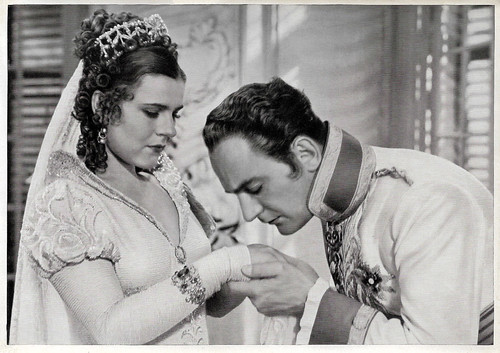
German collector card by Ross Verlag in the series 'Vom Werden deutscher Filmkunst - Der Tonfilm', album no. 11, picture no. 51. Photo: Cine-Allianz. Paula Wessely and Willi Forst in So endete eine Liebe/End of an Affair (Karl Hartl, 1934).
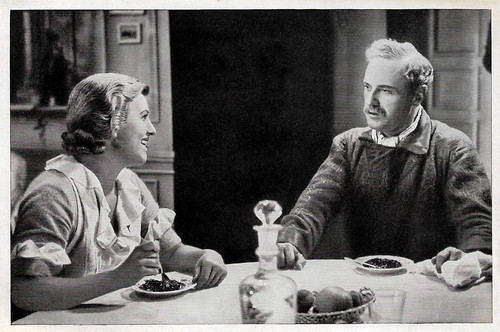
German collector card by Ross Verlag in the series 'Vom Werden deutscher Filmkunst - Der Tonfilm', album no. 11, picture no. 53. Photo: Terra-Film. Maria Paudler and Harry Liedtke in Wenn am Sonntagabend die Dorfmusik spielt/When the Village Band Plays on a Sunday Evening (Charles Klein, 1933).
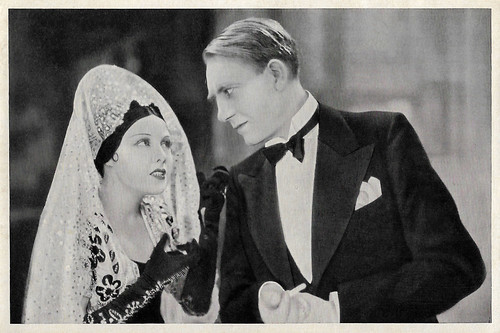
German collector card by Ross Verlag in the series 'Vom Werden deutscher Filmkunst - Der Tonfilm', album no. 11, picture no. 55, group 44. Photo: Ondra-Lamac-Film. Anny Ondra and Mathias Wieman in Fraulein Hoffmanns Erzählungen/The Tales of Ms. Hoffmann (Karel Lamac, 1933).
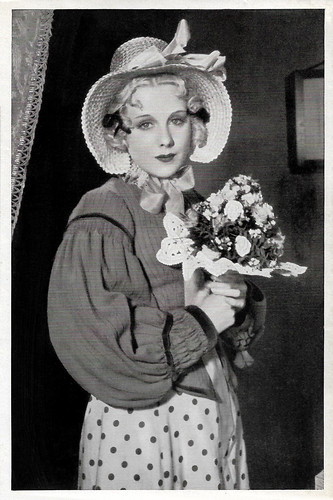
German collector card by Ross Verlag in the series 'Vom Werden deutscher Filmkunst - Der Tonfilm', album no. 11, picture no. 56. Photo: Ondra-Lamac-Film. Anny Ondra in Klein Dorrit/Little Dorrit (Karel Lamac, 1934).
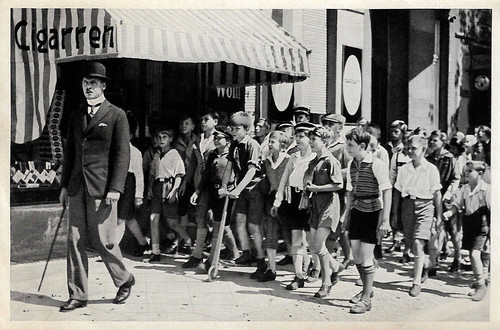
German collector card by Ross Verlag in the series 'Vom Werden deutscher Filmkunst - Der Tonfilm', album no. 11, picture no. 58, group 44. Photo: Ufa. Fritz Rasp in Emil und die Detektive/Emil and the Detectives (Gerhard Lamprecht, 1931).
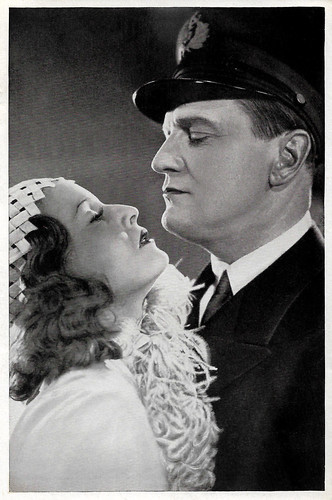
German collector card by Ross Verlag in the series 'Vom Werden deutscher Filmkunst - Der Tonfilm', album no. 11, picture no. 61. Photo: Ufa. Lilian Harvey and Harry Liedtke in Nie wieder Liebe!/No More Love (Anatole Litvak, 1931).
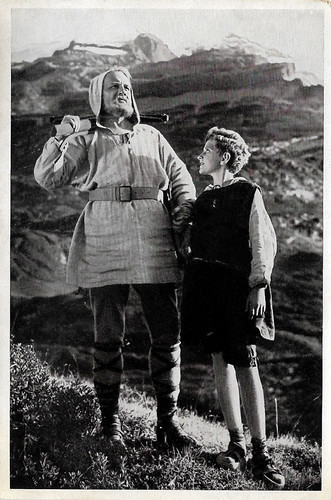
German collector card by Ross Verlag in the series 'Vom Werden deutscher Filmkunst - Der Tonfilm', album no. 11, picture no. 64. Photo: Terra-Filmg. Hans Marr as Wilhelm Tell and Detlef Willecke as his son Walter in Wilhelm Tell/The Legend of William Tell (Heinz Paul, 1934).
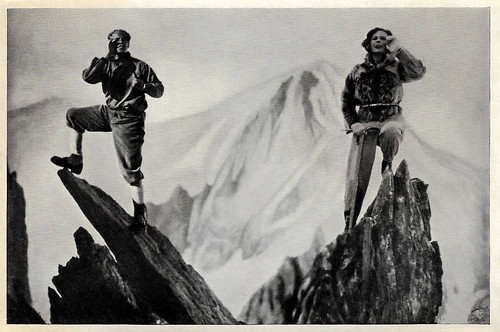
German collector card by Ross Verlag in the series 'Vom Werden deutscher Filmkunst - Der Tonfilm', album no. 11, picture no. 68, group 42. Photo: Aafa. Sepp Rist and Leni Riefenstahl in Stürme über dem Mont Blanc/Storm Over Mont Blanc (Arnold Fanck, 1930).
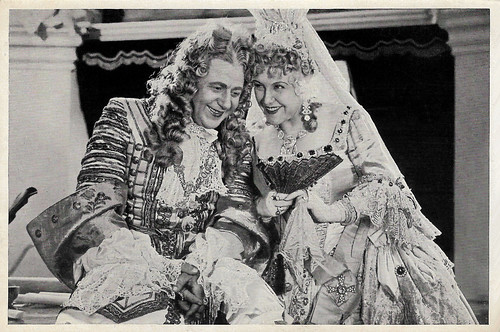
German collector card by Ross Verlag in the series 'Vom Werden deutscher Filmkunst - Der Tonfilm', album no. 11, picture no. 68, group 44. Photo: Ufa. Paul Hörbiger and Ida Wüst in Des jungen Dessauers grosse Liebe/The young Dessauer's great love (Arthur Robison, 1933).
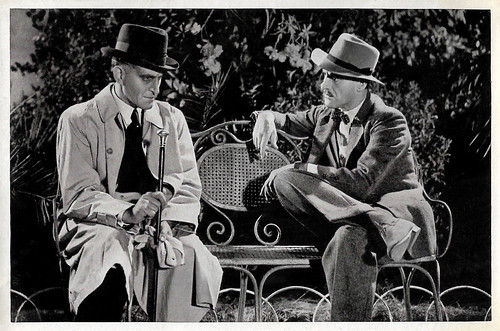
German collector card by Ross Verlag in the series 'Vom Werden deutscher Filmkunst - Der Tonfilm', album no. 11, picture no. 69. Photo: Ufa. Albrecht Schoenhals in a double role in Fürst Woronzeff/Prince Woronzeff (Arthur Robison, 1934).
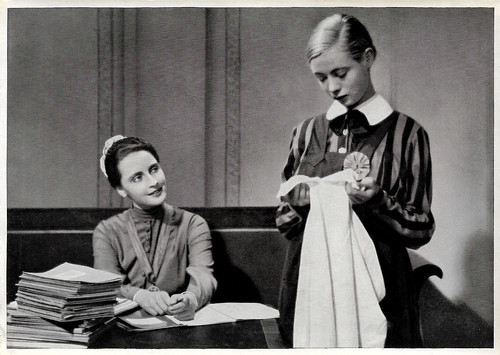
German collector card by Ross Verlag in the series 'Vom Werden deutscher Filmkunst - Der Tonfilm', album no. 11, picture no. 71. Photo: Froelich-Film. Dorothea Wieck and Hertha Thiele in Mädchen in Uniform/Girls in Uniform (Leontine Sagan, 1931).
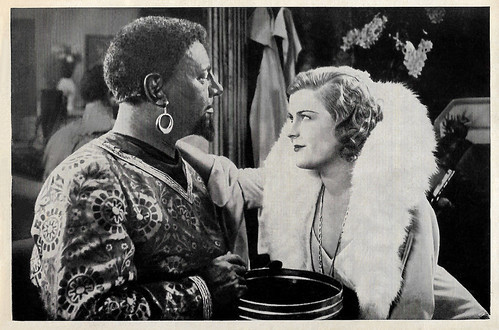
German collector card by Ross Verlag in the series 'Vom Werden deutscher Filmkunst - Der Tonfilm', album no. 11, picture no. 72, group 44. Photo: Ufa. Emil Jannings and Renate Müller in Liebling der Götter/Darling of the Gods (Hanns Schwarz, 1930).
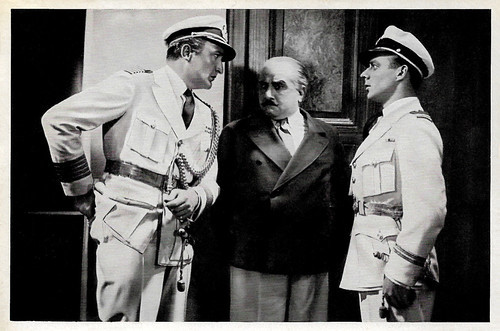
German collector card by Ross Verlag in the series 'Vom Werden deutscher Filmkunst - Der Tonfilm', album no. 11, picture no. 73. Photo: Ufa. Hans Albers , Karl Ettlinger and Heinz Rühmann in Bomben auf Monte Carlo/Bombs Over Monte Carlo (Hanns Schwarz, 1931).
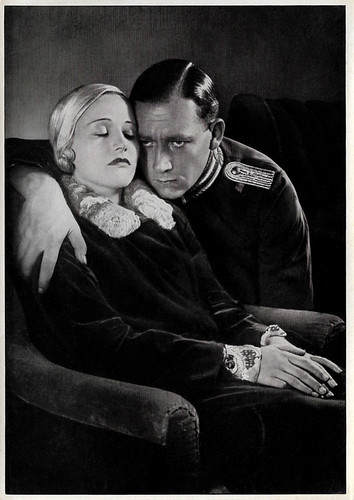
German collector card by Ross Verlag in the series 'Vom Werden deutscher Filmkunst - Der Tonfilm', album no. 11, picture no. 75. Photo: Ufa. Lien Deyers and Mathias Wieman in Rosenmontag/Love's Carnival (Hans Steinhoff, 1930).
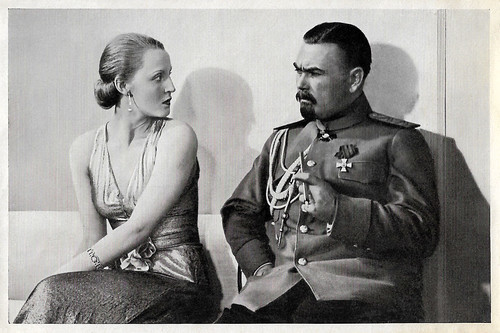
German collector card by Ross Verlag in the series 'Vom Werden deutscher Filmkunst - Der Tonfilm', album no. 11, picture no. 79. Photo: Ufa. Brigitte Helm and Oskar Homolka in Im Geheimdienst/In the Employ of the Secret Service (Gustav Ucicky, 1931).
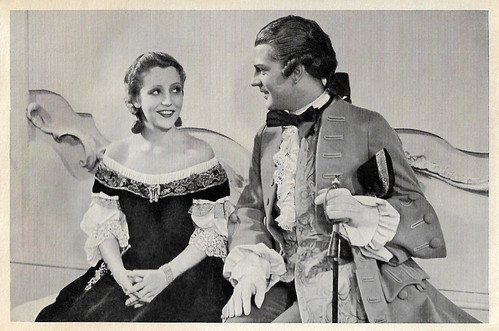
German collector card by Ross Verlag in the series 'Vom Werden deutscher Filmkunst - Der Tonfilm', album no. 11, picture no. 81, group 44. Photo: Ufa. Käthe von Nagy and Viktor de Kowa in Der junge Baron Neuhaus/Night in May (Gustav Ucicky, 1934).
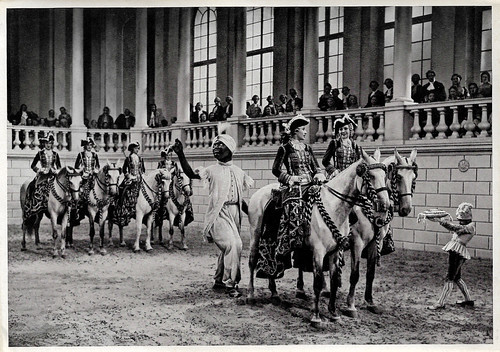
German collector card by Ross Verlag in the series 'Vom Werden deutscher Filmkunst - Der Tonfilm', album no. 11, picture no. 82. Photo: Ufa. Lola Chlud and Käthe von Nagy in Der junge Baron Neuhaus/Night in May (Gustav Ucicky, 1934).
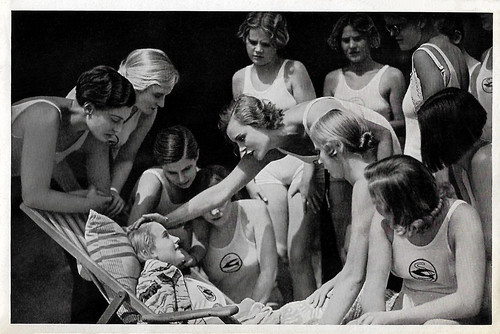
German collector card by Ross Verlag in the series 'Vom Werden deutscher Filmkunst - Der Tonfilm', album no. 11, picture no. 83. Photo: Fanal-Terra-Produktion. Karin Hardt in Acht Mädels im Boot/Eight Girls in a Boat (Erich Waschneck, 1932).
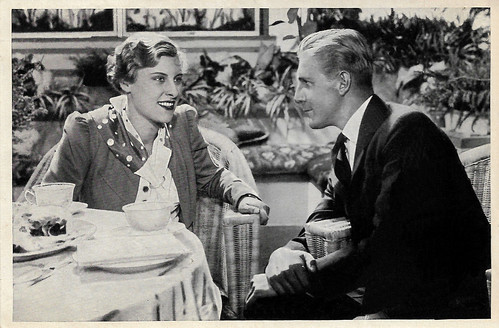
German collector card by Ross Verlag in the series 'Vom Werden deutscher Filmkunst - Der Tonfilm', album no. 11, picture no. 85, group 44. Photo: Ufa. Marianne Hoppe and Hans Schlenck in Heideschulmeister Uwe Karsten/The Country Schoolmaster (Carl Heinz Wolff, 1933).
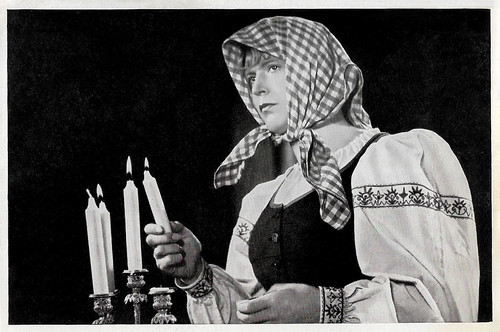
German collector card by Ross Verlag in the series 'Vom Werden deutscher Filmkunst - Der Tonfilm', album no. 11, image no. 87. Photo: Itala-Film. Gustav Fröhlich in Abenteuer eines jungen Herrn in Polen/Love and Alarm (Gustav Fröhlich, 1934).
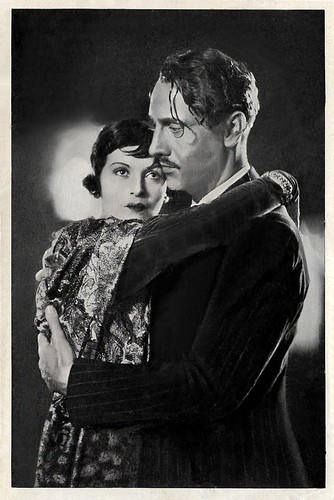
German collector card by Ross Verlag in the series 'Vom Werden deutscher Filmkunst - Der Tonfilm', album no. 11, picture no. 89. Photo: Ariel-Film. Sybille Schmitz and Siegfried Schürenberg in Der Herr der Welt/Master of the World (Harry Piel, 1934).
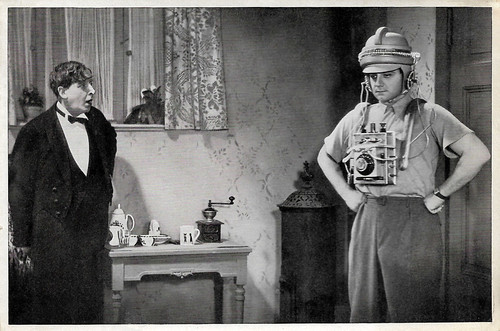
German collector card by Ross Verlag in the series 'Vom Werden deutscher Filmkunst - Der Tonfilm', album no. 11, picture no. 90. Photo: Ariel-Film. Fritz Odemar and Harry Piel in Ein Unsichtbarer geht durch die Stadt/An Invisible Man Goes Through the City (Harry Piel, 1934).
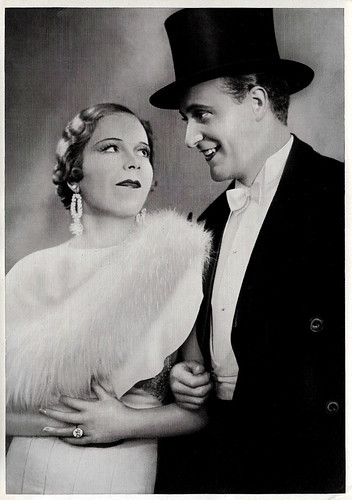
German collector card by Ross Verlag in the series 'Vom Werden deutscher Filmkunst - Der Tonfilm', album no. 11, picture no. 92. Photo: Ufa. Renate Müller and Willy Fritsch in Saison in Kairo/Cairo Season (Reinhold Schünzel, 1933).
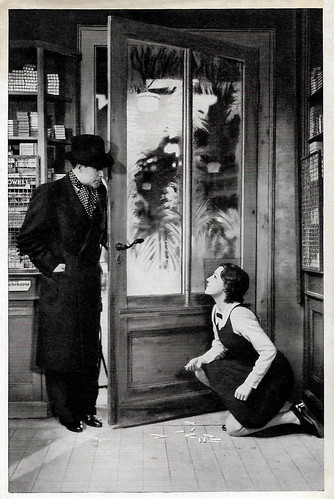
German collector card by Ross Verlag in the series 'Vom Werden deutscher Filmkunst - Der Tonfilm', album no. 11, picture no. 94. Photo: Ufa. Willy Fritsch and Käthe von Nagy in Die Töchter ihrer Exzellenz/The Daughters of Her Excellence (Reinhold Schünzel, 1934).
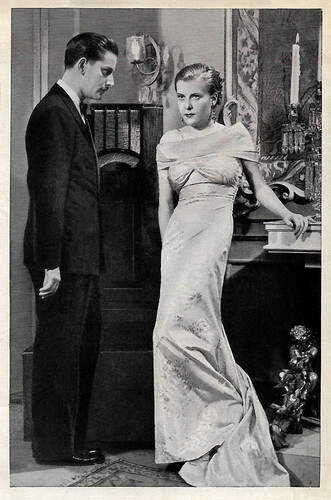
German collector card by Ross Verlag in the series 'Vom Werden deutscher Filmkunst - Der Tonfilm', album no. 11, picture no. 97, group 44. Photo: Cine-Allianz. Adolf Wohlbrück (Anton Walbrook) and Renate Müller in Die englische Heirat/The English Marriage (Reinhold Schünzel, 1934).
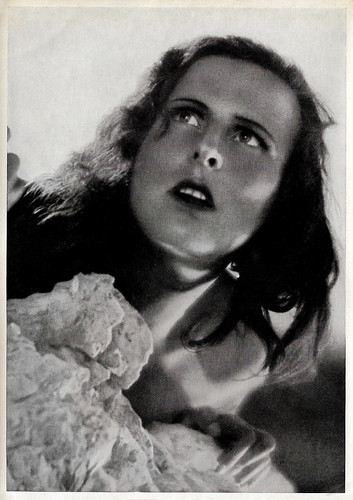
German collector card by Ross Verlag in the series 'Vom Werden deutscher Filmkunst - Der Tonfilm', album no. 11, picture no. 98. Photo: Aafa. Leni Riefenstahl in Das blaue Licht/The blaue Light (Leni Riefenstahl, 1932).
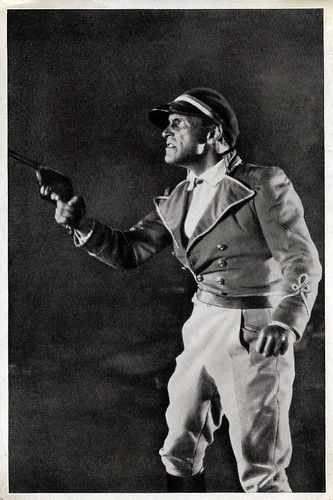
German collector card by Ross Verlag in the series 'Vom Werden deutscher Filmkunst - Der Tonfilm', album no. 11, picture no. 99. Photo: Deutsche Universal-Film A.G. Luis Trenker in Der Rebell/The Rebel (Kurt Bernhardt, Edwin H. Knopf, Luis Trenker, 1932).
To be continued next week.

German collector card by Ross Verlag in the series 'Vom Werden deutscher Filmkunst - Der Tonfilm', album no. 11, picture no. 51. Photo: Cine-Allianz. Paula Wessely and Willi Forst in So endete eine Liebe/End of an Affair (Karl Hartl, 1934).

German collector card by Ross Verlag in the series 'Vom Werden deutscher Filmkunst - Der Tonfilm', album no. 11, picture no. 53. Photo: Terra-Film. Maria Paudler and Harry Liedtke in Wenn am Sonntagabend die Dorfmusik spielt/When the Village Band Plays on a Sunday Evening (Charles Klein, 1933).

German collector card by Ross Verlag in the series 'Vom Werden deutscher Filmkunst - Der Tonfilm', album no. 11, picture no. 55, group 44. Photo: Ondra-Lamac-Film. Anny Ondra and Mathias Wieman in Fraulein Hoffmanns Erzählungen/The Tales of Ms. Hoffmann (Karel Lamac, 1933).

German collector card by Ross Verlag in the series 'Vom Werden deutscher Filmkunst - Der Tonfilm', album no. 11, picture no. 56. Photo: Ondra-Lamac-Film. Anny Ondra in Klein Dorrit/Little Dorrit (Karel Lamac, 1934).

German collector card by Ross Verlag in the series 'Vom Werden deutscher Filmkunst - Der Tonfilm', album no. 11, picture no. 58, group 44. Photo: Ufa. Fritz Rasp in Emil und die Detektive/Emil and the Detectives (Gerhard Lamprecht, 1931).

German collector card by Ross Verlag in the series 'Vom Werden deutscher Filmkunst - Der Tonfilm', album no. 11, picture no. 61. Photo: Ufa. Lilian Harvey and Harry Liedtke in Nie wieder Liebe!/No More Love (Anatole Litvak, 1931).

German collector card by Ross Verlag in the series 'Vom Werden deutscher Filmkunst - Der Tonfilm', album no. 11, picture no. 64. Photo: Terra-Filmg. Hans Marr as Wilhelm Tell and Detlef Willecke as his son Walter in Wilhelm Tell/The Legend of William Tell (Heinz Paul, 1934).

German collector card by Ross Verlag in the series 'Vom Werden deutscher Filmkunst - Der Tonfilm', album no. 11, picture no. 68, group 42. Photo: Aafa. Sepp Rist and Leni Riefenstahl in Stürme über dem Mont Blanc/Storm Over Mont Blanc (Arnold Fanck, 1930).

German collector card by Ross Verlag in the series 'Vom Werden deutscher Filmkunst - Der Tonfilm', album no. 11, picture no. 68, group 44. Photo: Ufa. Paul Hörbiger and Ida Wüst in Des jungen Dessauers grosse Liebe/The young Dessauer's great love (Arthur Robison, 1933).

German collector card by Ross Verlag in the series 'Vom Werden deutscher Filmkunst - Der Tonfilm', album no. 11, picture no. 69. Photo: Ufa. Albrecht Schoenhals in a double role in Fürst Woronzeff/Prince Woronzeff (Arthur Robison, 1934).

German collector card by Ross Verlag in the series 'Vom Werden deutscher Filmkunst - Der Tonfilm', album no. 11, picture no. 71. Photo: Froelich-Film. Dorothea Wieck and Hertha Thiele in Mädchen in Uniform/Girls in Uniform (Leontine Sagan, 1931).

German collector card by Ross Verlag in the series 'Vom Werden deutscher Filmkunst - Der Tonfilm', album no. 11, picture no. 72, group 44. Photo: Ufa. Emil Jannings and Renate Müller in Liebling der Götter/Darling of the Gods (Hanns Schwarz, 1930).

German collector card by Ross Verlag in the series 'Vom Werden deutscher Filmkunst - Der Tonfilm', album no. 11, picture no. 73. Photo: Ufa. Hans Albers , Karl Ettlinger and Heinz Rühmann in Bomben auf Monte Carlo/Bombs Over Monte Carlo (Hanns Schwarz, 1931).

German collector card by Ross Verlag in the series 'Vom Werden deutscher Filmkunst - Der Tonfilm', album no. 11, picture no. 75. Photo: Ufa. Lien Deyers and Mathias Wieman in Rosenmontag/Love's Carnival (Hans Steinhoff, 1930).

German collector card by Ross Verlag in the series 'Vom Werden deutscher Filmkunst - Der Tonfilm', album no. 11, picture no. 79. Photo: Ufa. Brigitte Helm and Oskar Homolka in Im Geheimdienst/In the Employ of the Secret Service (Gustav Ucicky, 1931).

German collector card by Ross Verlag in the series 'Vom Werden deutscher Filmkunst - Der Tonfilm', album no. 11, picture no. 81, group 44. Photo: Ufa. Käthe von Nagy and Viktor de Kowa in Der junge Baron Neuhaus/Night in May (Gustav Ucicky, 1934).

German collector card by Ross Verlag in the series 'Vom Werden deutscher Filmkunst - Der Tonfilm', album no. 11, picture no. 82. Photo: Ufa. Lola Chlud and Käthe von Nagy in Der junge Baron Neuhaus/Night in May (Gustav Ucicky, 1934).

German collector card by Ross Verlag in the series 'Vom Werden deutscher Filmkunst - Der Tonfilm', album no. 11, picture no. 83. Photo: Fanal-Terra-Produktion. Karin Hardt in Acht Mädels im Boot/Eight Girls in a Boat (Erich Waschneck, 1932).

German collector card by Ross Verlag in the series 'Vom Werden deutscher Filmkunst - Der Tonfilm', album no. 11, picture no. 85, group 44. Photo: Ufa. Marianne Hoppe and Hans Schlenck in Heideschulmeister Uwe Karsten/The Country Schoolmaster (Carl Heinz Wolff, 1933).

German collector card by Ross Verlag in the series 'Vom Werden deutscher Filmkunst - Der Tonfilm', album no. 11, image no. 87. Photo: Itala-Film. Gustav Fröhlich in Abenteuer eines jungen Herrn in Polen/Love and Alarm (Gustav Fröhlich, 1934).

German collector card by Ross Verlag in the series 'Vom Werden deutscher Filmkunst - Der Tonfilm', album no. 11, picture no. 89. Photo: Ariel-Film. Sybille Schmitz and Siegfried Schürenberg in Der Herr der Welt/Master of the World (Harry Piel, 1934).

German collector card by Ross Verlag in the series 'Vom Werden deutscher Filmkunst - Der Tonfilm', album no. 11, picture no. 90. Photo: Ariel-Film. Fritz Odemar and Harry Piel in Ein Unsichtbarer geht durch die Stadt/An Invisible Man Goes Through the City (Harry Piel, 1934).

German collector card by Ross Verlag in the series 'Vom Werden deutscher Filmkunst - Der Tonfilm', album no. 11, picture no. 92. Photo: Ufa. Renate Müller and Willy Fritsch in Saison in Kairo/Cairo Season (Reinhold Schünzel, 1933).

German collector card by Ross Verlag in the series 'Vom Werden deutscher Filmkunst - Der Tonfilm', album no. 11, picture no. 94. Photo: Ufa. Willy Fritsch and Käthe von Nagy in Die Töchter ihrer Exzellenz/The Daughters of Her Excellence (Reinhold Schünzel, 1934).

German collector card by Ross Verlag in the series 'Vom Werden deutscher Filmkunst - Der Tonfilm', album no. 11, picture no. 97, group 44. Photo: Cine-Allianz. Adolf Wohlbrück (Anton Walbrook) and Renate Müller in Die englische Heirat/The English Marriage (Reinhold Schünzel, 1934).

German collector card by Ross Verlag in the series 'Vom Werden deutscher Filmkunst - Der Tonfilm', album no. 11, picture no. 98. Photo: Aafa. Leni Riefenstahl in Das blaue Licht/The blaue Light (Leni Riefenstahl, 1932).

German collector card by Ross Verlag in the series 'Vom Werden deutscher Filmkunst - Der Tonfilm', album no. 11, picture no. 99. Photo: Deutsche Universal-Film A.G. Luis Trenker in Der Rebell/The Rebel (Kurt Bernhardt, Edwin H. Knopf, Luis Trenker, 1932).
To be continued next week.
Published on February 25, 2025 22:00
February 24, 2025
La Collectionneuse: Mae Busch
Mae Busch had a long, prolific and interesting career in the silents, with such highlights as Erich von Stroheim’s The Devil’s Passkey (1920) and Foolish Wives (1922), and Tod Browning’s The Unholy Three (1925) and While the City Sleeps (1928). But it will probably be for her roles in several Laurel and Hardy films, especially as a shrewish and sharp-tongued wife to Oliver, that she will be remembered. Here are a few examples of her angry tirades aimed at the poor Oliver:
I’m sick and tired of cooking to you and all the bums that you happen to bring up here for dinner. And I’m not going to do it any longer.(From Unaccustomed As We Are).
I warn you, Oliver Hardy: you go out with that Laurel again and I’m through. You get me? (From Their First Mistake).
If you think you’re going off gallivanting with a lot of hoodlums to any convention whenever you want to, well you’re not. Not for a minute you’re not.(From Sons of the Desert).
You big bag of suet. I told you five minutes ago not to talk to me. I told you an hour ago. I told you a week ago. I suppose you think you can contradict everything I say? Well you can’t, you can’t, you can’t. You never will. (From The Bohemian Girl).
She was also not averse to breaking different objects over his head or chasing him away with a broom. Even when she was reduced to small roles later in her career, Mae never lost her knack for delivering a line. For example, in Ziegfeld Girl (1941), she played Jenny, the wardrobe lady. In a scene, Hedy Lamarr, before going on stage in a Ziegfeld show, complains to Jenny that she is too nervous to put her lipstick on, to which she wittily replies: Relax honey. They won’t be looking at your mouth.
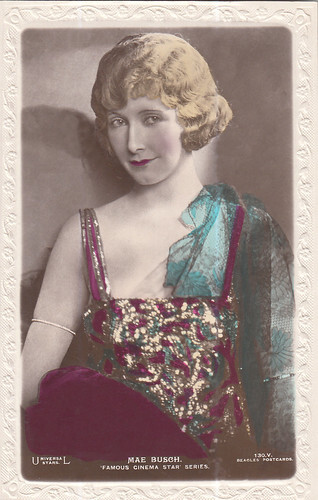
British postcard in the Famous Cinema Stars Series by Beagles, no. 130 V. Photo: Universal.
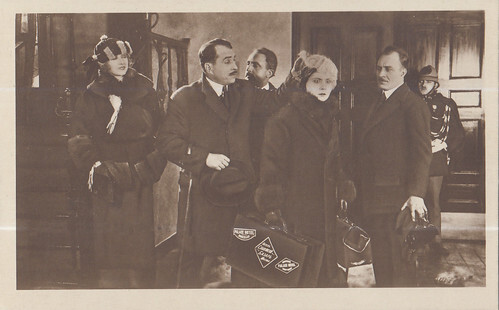
Vintage postcard. Mae Busch (on the left) and Maud George (in the centre) in Foolish Wives (Erich von Stroheim, 1922). The postcards in this series have no caption on the front. On the back, a printed text in Spanish advertises the release of Foolish Wives and bears the mention “La Sud Americana”. German company Ross Verlag most likely produced them for the South American market, as these postcards look the same as the Foolish Wives set of postcards issued by Ross.
A seasoned stage performer
Mae Busch was born Annie May Busch on 18 June 1891 in Melbourne, Australia.
Her parents were Vaudevillians Frederick William Busch and Elizabeth Maria Lay.
Her mother would often use the pseudonym Dora Devere during her stage career.
At the end of the 19th Century, the family relocated to the U.S.A., where Mae was placed in a convent school in New Jersey.
In 1903, she joined her parents in a Vaudeville act called The Busch Revere Trio which lasted until 1912. Mae also appeared on her own in several plays and shows.
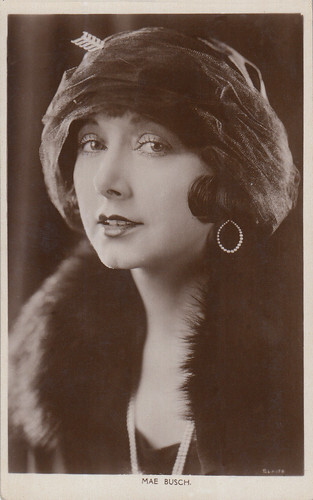
British postcard in the Picturegoer Series, London, no. 79.
Keystone comedies
Mae Busch made her official film debut in 1915 at Keystone, where she appeared opposite comedians such as Charley Chase, Chester Conklin, Mack Swain, Harry McCoy and William Collier Sr.
Her films include Ambrose’s Sour Grapes (1915), Love in Armour (1915), The Rent Jumpers (1915), Merely a Married Man (1915), A Rascal’s Wolfish Ways (1915), Because He Loved Her (1916), Better Late Than Never (1916), Wife and Auto Trouble (1916) and A Bath House Blunder (1916).
According to some sources, Mae allegedly would have had an affair with Keystone’s boss Mack Sennett, much to star Mabel Normand ’s dismay.
But it seems that neither Busch nor Normand ever made a public comment about it.
So, we will probably never know the long and short of this story.
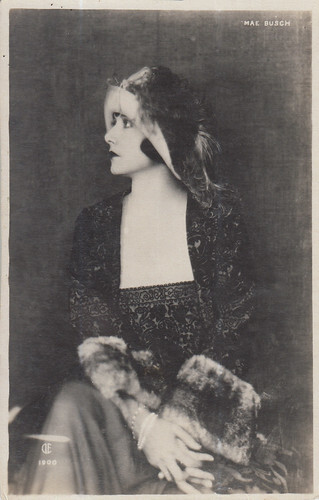
Mexican postcard by CIF, no. 1900.
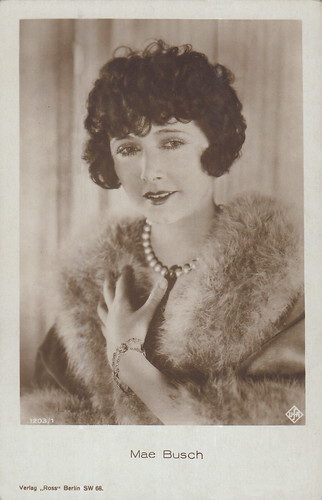
German postcard by Verlag Ross, Berlin, no. 1203/1, 1927-1928. Photo: Ufa.
Big breaks with Erich von Stroheim
After leaving Keystone, Mae appeared in two other shorts at IMP and Fox and made her feature film debut in a Vivian Martin vehicle, The Fair Barbarian (1917).
She then played a villain opposite famous magician Harry Houdini in The Grim Game (1919).
She got a break when Erich von Stroheim gave her a role in The Devil’s Passkey (1920).
After having supported Enid Bennett in Her Husband’s Friend (1920), Wanda Hawley in The Love Charm (1921) and Marie Prevost in A Parisian Scandal (1921), she was again directed by Erich von Stroheim in Foolish Wives (1922).
Mae played an adventuress passing for a Russian countess. Foolish Wives was one of the 1922 box-office winners.
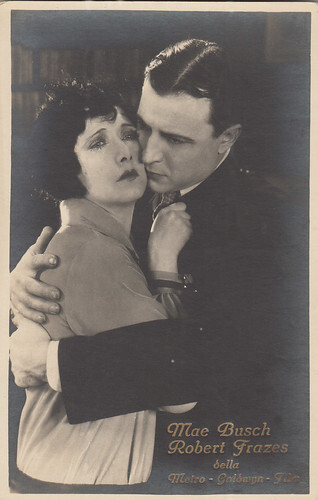
Italian postcard by G.B. Falci Editore, Milano, no. 421. Photo: Metro-Goldwyn. Mae Busch and Robert Frazer in Bread (Victor Schertzinger, 1924).
At the top of her career
Mae Busch’s career was in the ascent when she was chosen for the leading role of Glory Quayle in The Christian (1923).
It had been a best-selling novel, before becoming a Broadway success for actress Viola Allen during the 1898-1899 season and had already been adapted for the screen three times before.
For two years, she was at the top of her career by starring in movies such as Name the Man! (1924), A Woman Who Sinned (1924), Bread (1924), Broken Barriers (1924), Married Flirts (1924), Frivolous Sal (1925), Camille of the Barbary Coast (1925), Time, the Comedian (1925), etc.
She was also directed by Tod Browning in The Unholy Three (1925), opposite Lon Chaney .
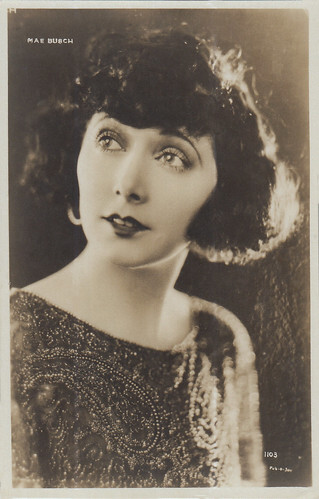
Mexican postcard, no. 1103.
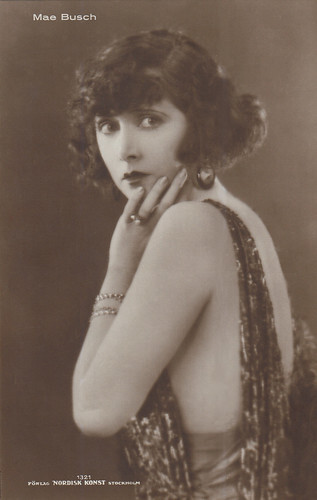
Swedish postcard by Förlag Nordisk Konst, no. 1321.
Minor Hollywood studios
From 1926 on, Mae Busch mostly got starring parts at minor Hollywood studios such as Tiffany in Fools of Fashion (1926), Husband Hunters (1927) and The Beauty Shoppers (1927).
For Sterling Pictures, she starred in Tongues of Scandal (1927) and Gotham in San Francisco Nights (1928). For Carlos Productions, she appeared in Black Butterflies (1928).
Still, she occasionally had the opportunity to appear in more prestigious productions, like Universal’s Perch of the Devil (1927).
Mae also acted in Fox’s Fazil (1928), supporting Greta Nissen and Charles Farrell .
In M.G.M.’s While the City Sleeps (1928), she was reunited with director Tod Browning and co-star Lon Chaney .
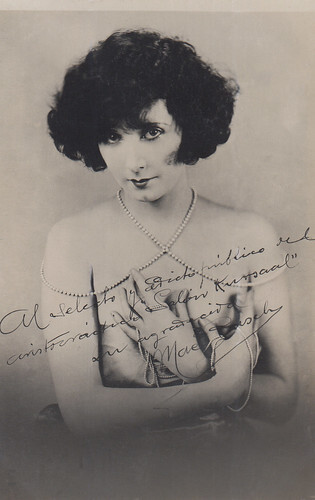
Spanish postcard in the Kursaal series.
The advent of the talkies
Mae Busch made her talking debut in Roland West’s gangster melodrama Alibi (1929), which was nominated in the Academy Award Best Picture category.
After the advent of sound, Mae appeared, until her death, in dozens of movies in supporting parts.
Over the years, the supporting parts became bit roles, several of them uncredited.
It’s a pity that, except for Hal Roach, directors or producers didn’t usually give her meatier roles.
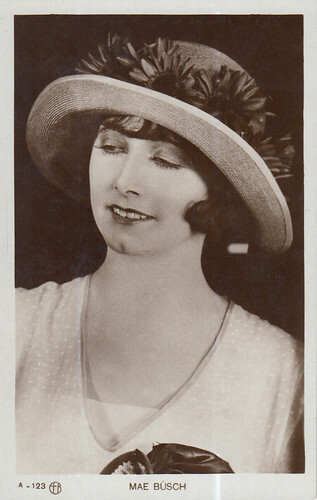
Spanish postcard by Editorial Fotografica Barcelona, no. A-123. Mae Busch in The Unholy Three (Tod Browning, 1925).
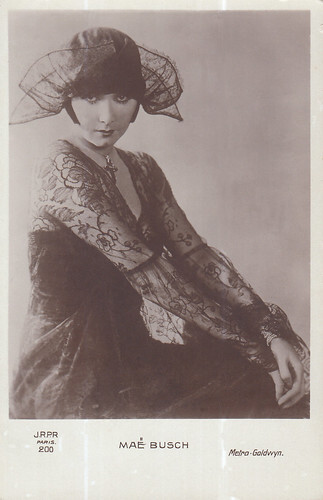
French postcard by J.R.P.R., no. 200. Photo: Metro-Goldwyn.
Her work with Laurel and Hardy
In 1927, Mae Busch headed the cast of the Hal Roach comedy Love’Em and Weep (1927). In it, Stan Laurel tried to keep a blackmailing Mae away from her married friend, played by James Finlayson, and Oliver Hardy had a bit part as a judge.
By 1929, Laurel and Hardy had become a hugely popular team and Hal Roach then got the good idea to have Mae Busch play Hardy’s strong-willed and domineering wife in Unaccustomed As We Are (1929). With her experience and perfect comic timing, she proved to be a perfect screen partner for Stan and Oliver.
She was again Hardy’s bickering wife in Their First Mistake (1932), Sons of the Desert (1933) and The Bohemian Girl (1936).
Her other films with the pair are Chickens Go Home (1931), as Hardy’s blackmailing old flame, Come Clean (1931), as a woman they save from suicide who not only proves to be a troublemaker but a fugitive from the police as well, Oliver the Eight (1934), as a mentally disturbed murderess who intends to kill Oliver, Going Bye-Bye! (1934), as a gangster’s moll, The Live Ghost (1934), as Maisie the Vamp, Them Thar Hills (1934) and its sequel Tit for Tat (1935), as wife to a suspicious Charlie Hall, and The Fixer Uppers (1935), as a woman distraught over her husband’s neglect.
Several sources claim that she would have sued Hal Roach for feet injuries sustained during filming The Bohemian Girl but she would have lost the case. In any event, She never worked for Hal Roach again.
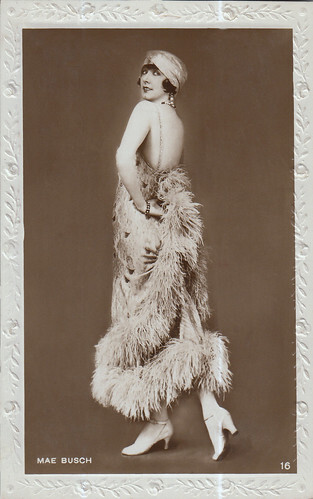
British postcard, no. 16.
Final years
In December 1940, Mae Busch was one of the many guests at the opening of the Mabel Normand Sound Stage at Republic Studios. It still survives today in Studio City, Los Angeles.
Mae Busch passed away on 20 April 1946, from colon cancer. At the time of her death, she was still married to Thomas Tate, her third husband.
For unknown reasons, her ashes remained unclaimed for many years.
In the 1970s, The 'Way out West Tent', a chapter of the 'Sons of the Desert', a famous Laurel and Hardy appreciation society, saw to it that her ashes would be transferred to the Los Angeles Chapel of the Pines crematory and columbarium.
In the 1950s, she became the subject of a running gag in Jackie Gleason’s television shows. Naming the casts of old pictures, he always wound up with "and the ever-popular Mae Busch".
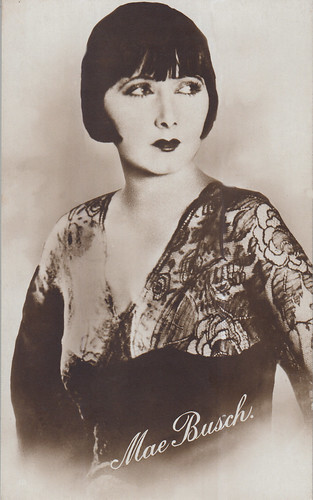
British postcard issued with Sarony cigarettes, no. 26 of a series of 38 cinema stars.
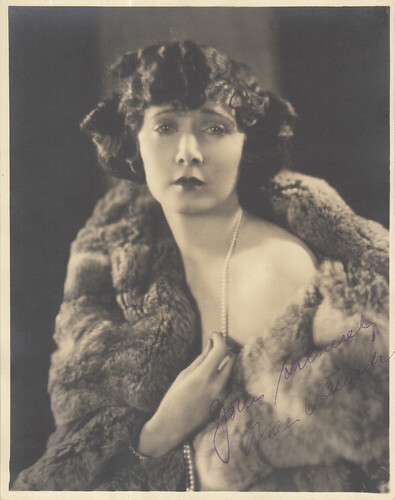
Autographed photograph.
Text and postcards: Marlene Pilaete.
I’m sick and tired of cooking to you and all the bums that you happen to bring up here for dinner. And I’m not going to do it any longer.(From Unaccustomed As We Are).
I warn you, Oliver Hardy: you go out with that Laurel again and I’m through. You get me? (From Their First Mistake).
If you think you’re going off gallivanting with a lot of hoodlums to any convention whenever you want to, well you’re not. Not for a minute you’re not.(From Sons of the Desert).
You big bag of suet. I told you five minutes ago not to talk to me. I told you an hour ago. I told you a week ago. I suppose you think you can contradict everything I say? Well you can’t, you can’t, you can’t. You never will. (From The Bohemian Girl).
She was also not averse to breaking different objects over his head or chasing him away with a broom. Even when she was reduced to small roles later in her career, Mae never lost her knack for delivering a line. For example, in Ziegfeld Girl (1941), she played Jenny, the wardrobe lady. In a scene, Hedy Lamarr, before going on stage in a Ziegfeld show, complains to Jenny that she is too nervous to put her lipstick on, to which she wittily replies: Relax honey. They won’t be looking at your mouth.

British postcard in the Famous Cinema Stars Series by Beagles, no. 130 V. Photo: Universal.

Vintage postcard. Mae Busch (on the left) and Maud George (in the centre) in Foolish Wives (Erich von Stroheim, 1922). The postcards in this series have no caption on the front. On the back, a printed text in Spanish advertises the release of Foolish Wives and bears the mention “La Sud Americana”. German company Ross Verlag most likely produced them for the South American market, as these postcards look the same as the Foolish Wives set of postcards issued by Ross.
A seasoned stage performer
Mae Busch was born Annie May Busch on 18 June 1891 in Melbourne, Australia.
Her parents were Vaudevillians Frederick William Busch and Elizabeth Maria Lay.
Her mother would often use the pseudonym Dora Devere during her stage career.
At the end of the 19th Century, the family relocated to the U.S.A., where Mae was placed in a convent school in New Jersey.
In 1903, she joined her parents in a Vaudeville act called The Busch Revere Trio which lasted until 1912. Mae also appeared on her own in several plays and shows.

British postcard in the Picturegoer Series, London, no. 79.
Keystone comedies
Mae Busch made her official film debut in 1915 at Keystone, where she appeared opposite comedians such as Charley Chase, Chester Conklin, Mack Swain, Harry McCoy and William Collier Sr.
Her films include Ambrose’s Sour Grapes (1915), Love in Armour (1915), The Rent Jumpers (1915), Merely a Married Man (1915), A Rascal’s Wolfish Ways (1915), Because He Loved Her (1916), Better Late Than Never (1916), Wife and Auto Trouble (1916) and A Bath House Blunder (1916).
According to some sources, Mae allegedly would have had an affair with Keystone’s boss Mack Sennett, much to star Mabel Normand ’s dismay.
But it seems that neither Busch nor Normand ever made a public comment about it.
So, we will probably never know the long and short of this story.

Mexican postcard by CIF, no. 1900.

German postcard by Verlag Ross, Berlin, no. 1203/1, 1927-1928. Photo: Ufa.
Big breaks with Erich von Stroheim
After leaving Keystone, Mae appeared in two other shorts at IMP and Fox and made her feature film debut in a Vivian Martin vehicle, The Fair Barbarian (1917).
She then played a villain opposite famous magician Harry Houdini in The Grim Game (1919).
She got a break when Erich von Stroheim gave her a role in The Devil’s Passkey (1920).
After having supported Enid Bennett in Her Husband’s Friend (1920), Wanda Hawley in The Love Charm (1921) and Marie Prevost in A Parisian Scandal (1921), she was again directed by Erich von Stroheim in Foolish Wives (1922).
Mae played an adventuress passing for a Russian countess. Foolish Wives was one of the 1922 box-office winners.

Italian postcard by G.B. Falci Editore, Milano, no. 421. Photo: Metro-Goldwyn. Mae Busch and Robert Frazer in Bread (Victor Schertzinger, 1924).
At the top of her career
Mae Busch’s career was in the ascent when she was chosen for the leading role of Glory Quayle in The Christian (1923).
It had been a best-selling novel, before becoming a Broadway success for actress Viola Allen during the 1898-1899 season and had already been adapted for the screen three times before.
For two years, she was at the top of her career by starring in movies such as Name the Man! (1924), A Woman Who Sinned (1924), Bread (1924), Broken Barriers (1924), Married Flirts (1924), Frivolous Sal (1925), Camille of the Barbary Coast (1925), Time, the Comedian (1925), etc.
She was also directed by Tod Browning in The Unholy Three (1925), opposite Lon Chaney .

Mexican postcard, no. 1103.

Swedish postcard by Förlag Nordisk Konst, no. 1321.
Minor Hollywood studios
From 1926 on, Mae Busch mostly got starring parts at minor Hollywood studios such as Tiffany in Fools of Fashion (1926), Husband Hunters (1927) and The Beauty Shoppers (1927).
For Sterling Pictures, she starred in Tongues of Scandal (1927) and Gotham in San Francisco Nights (1928). For Carlos Productions, she appeared in Black Butterflies (1928).
Still, she occasionally had the opportunity to appear in more prestigious productions, like Universal’s Perch of the Devil (1927).
Mae also acted in Fox’s Fazil (1928), supporting Greta Nissen and Charles Farrell .
In M.G.M.’s While the City Sleeps (1928), she was reunited with director Tod Browning and co-star Lon Chaney .

Spanish postcard in the Kursaal series.
The advent of the talkies
Mae Busch made her talking debut in Roland West’s gangster melodrama Alibi (1929), which was nominated in the Academy Award Best Picture category.
After the advent of sound, Mae appeared, until her death, in dozens of movies in supporting parts.
Over the years, the supporting parts became bit roles, several of them uncredited.
It’s a pity that, except for Hal Roach, directors or producers didn’t usually give her meatier roles.

Spanish postcard by Editorial Fotografica Barcelona, no. A-123. Mae Busch in The Unholy Three (Tod Browning, 1925).

French postcard by J.R.P.R., no. 200. Photo: Metro-Goldwyn.
Her work with Laurel and Hardy
In 1927, Mae Busch headed the cast of the Hal Roach comedy Love’Em and Weep (1927). In it, Stan Laurel tried to keep a blackmailing Mae away from her married friend, played by James Finlayson, and Oliver Hardy had a bit part as a judge.
By 1929, Laurel and Hardy had become a hugely popular team and Hal Roach then got the good idea to have Mae Busch play Hardy’s strong-willed and domineering wife in Unaccustomed As We Are (1929). With her experience and perfect comic timing, she proved to be a perfect screen partner for Stan and Oliver.
She was again Hardy’s bickering wife in Their First Mistake (1932), Sons of the Desert (1933) and The Bohemian Girl (1936).
Her other films with the pair are Chickens Go Home (1931), as Hardy’s blackmailing old flame, Come Clean (1931), as a woman they save from suicide who not only proves to be a troublemaker but a fugitive from the police as well, Oliver the Eight (1934), as a mentally disturbed murderess who intends to kill Oliver, Going Bye-Bye! (1934), as a gangster’s moll, The Live Ghost (1934), as Maisie the Vamp, Them Thar Hills (1934) and its sequel Tit for Tat (1935), as wife to a suspicious Charlie Hall, and The Fixer Uppers (1935), as a woman distraught over her husband’s neglect.
Several sources claim that she would have sued Hal Roach for feet injuries sustained during filming The Bohemian Girl but she would have lost the case. In any event, She never worked for Hal Roach again.

British postcard, no. 16.
Final years
In December 1940, Mae Busch was one of the many guests at the opening of the Mabel Normand Sound Stage at Republic Studios. It still survives today in Studio City, Los Angeles.
Mae Busch passed away on 20 April 1946, from colon cancer. At the time of her death, she was still married to Thomas Tate, her third husband.
For unknown reasons, her ashes remained unclaimed for many years.
In the 1970s, The 'Way out West Tent', a chapter of the 'Sons of the Desert', a famous Laurel and Hardy appreciation society, saw to it that her ashes would be transferred to the Los Angeles Chapel of the Pines crematory and columbarium.
In the 1950s, she became the subject of a running gag in Jackie Gleason’s television shows. Naming the casts of old pictures, he always wound up with "and the ever-popular Mae Busch".

British postcard issued with Sarony cigarettes, no. 26 of a series of 38 cinema stars.

Autographed photograph.
Text and postcards: Marlene Pilaete.
Published on February 24, 2025 22:00
February 23, 2025
Judi Dench
British actress Judi Dench (1934) is best known for her role of M in the James Bond films. In 1999, she won the Oscar for Best Female Supporting Actress in Shakespeare in Love (1998). Dench appeared in many other films, plays and TV shows for which she received an oeuvre award at the European Film Awards in 2008. That year, she was also awarded a Dame Commander of the Order of the British Empire, becoming Dame Judi Dench.
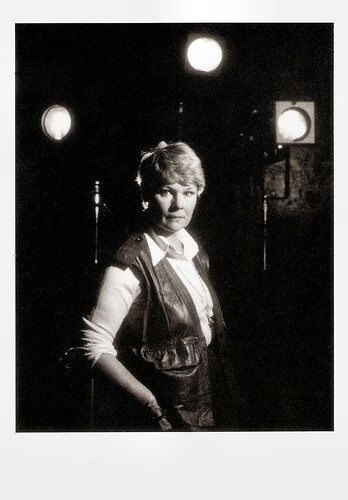
British postcard and photo by Robert Workman, Theatrical Photographer. Caption: Dame Judi Dench, Actress.
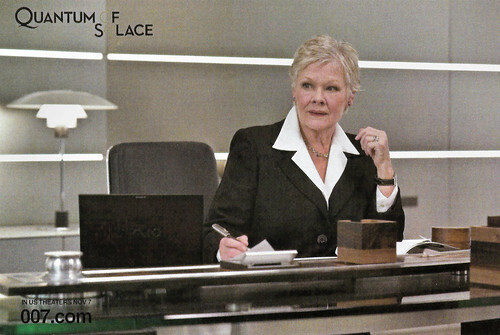
Chinese postcard by Oriental City Publishing Group Limited. Judi Dench as M in Quantum of Solace (Marc Forster, 2008).
Most Promising Newcomer
Dame Judith Olivia Dench was born in Heworth, York, in 1934. Dench was the daughter of Eleanora Olive (born Jones) and Reginald Arthur Dench of Dorset, a doctor and an amateur actor. She has a younger brother Jeffrey, an actor and an older brother Peter, a doctor. She grew up a Quaker and lived in Tyldesley, Greater Manchester.
When Dench was thirteen she went to The Mount School in York. Her original ambition was to be a designer and she trained as a costume designer. At 23, she made her professional debut as Ophelia in 'Hamlet' in Liverpool in 1957. That same year, she made her debut in the Old Vic.
Although most of Dench's work during this early period was in theatre, she also branched out into film work and won a BAFTA Award as Most Promising Newcomer. In 1968, she drew excellent reviews for her leading role as Sally Bowles in the musical 'Cabaret'. Through the years, she performed with the Royal Shakespeare Company, the National Theatre, and at Old Vic Theatre, and played virtually most of Shakespeare's leading ladies.
For her stage work, she won many awards including the 1982 London Critics' Circle Theatre Award for 'A Kind of Alaska' and 'The Importance of Being Earnest', the 1996 Laurence Olivier Theatre Award for 'A Little Night Music' and the 1999 Tony Award for Best Broadway Actress in 'Amy's View'. In 1971, she married British actor Michael Williams, with whom she had a child, actress Tara Cressida 'Finty' Williams.
Dench and Michael Williams starred in many plays and TV shows together, including Bob Larby's sitcom, A Fine Romance (1981-1984). She is a ten-time BAFTA winner including Best Actress in a Comedy Series for A Fine Romance (1981), Best Supporting Actress in A Room with a View (James Ivory, 1985) and A Handful of Dust (1988). She also received an ACE award for her performance in the television series Mr & Mrs Edgehill (1985).
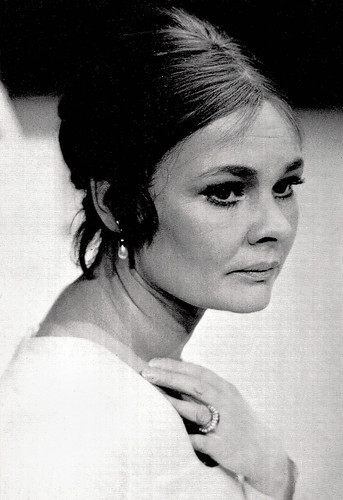
British postcard in the Royal Shakespeare Theatre series, no. 86. Photo: Joe Cocks. Judi Dench as Hermione in 'The Winter's Tale' by William Shakespeare, Stratford-upon-Avon, 1969.
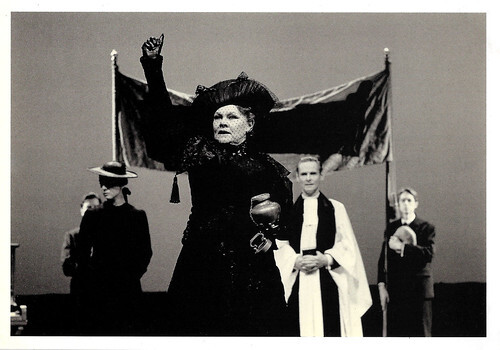
British postcard by Royal National Theatre, no. NT 55. Photo: Mark Douet. Judi Dench in 'The Sea' (1991) by Edward Bond (Lyttelton Theatre, 1991).
The first female M
Judi Dench became best known to the general public for her role of M in the James Bond films, which she played from GoldenEye (Martin Campbell, 1995) with Pierce Brosnan through Skyfall (Sam Mendes, 2012) starring Daniel Craig , where M lost her life after a siege of Skyfall, James Bond's parents' castle.
She was the first woman to portray the character. Judi Dench became known for playing dignified, strong-willed women in positions of authority, who are sometimes opposed or criticised by those under them. She won her first Oscar nomination for Mrs Brown (John Madden, 1996). It was her breakthrough as a film actress. In 1999, she won the Oscar for Best Female Supporting Actress in Shakespeare in Love (John Madden, 1998). It was for a six-minute performance in only four scenes as Queen Elizabeth I.
Following her Oscar win, the producers of the Bond franchise gave her character M a much larger role, central to the film's plot, for the first time in the Bond franchise. While M had typically only been seen in Bond films in bookend scenes at the very beginning and end, this time around the writers made her past actions the primary motive for the film's two main villains.
Her other Oscar-nominated roles are Chocolat (Lasse Hallström, 2000) with Juliette Binoche , Iris (Richard Eyre, 2001) with Kate Winslet , Mrs Henderson Presents (Stephen Frears, 2005) with Bob Hoskins, Notes on a Scandal (Richard Eyre, 2006) with Cate Blanchett , Philomena (Stephen Frears, 2013) with Steve Coogan, and Belfast (Kenneth Branagh, 2021).
In May 2024, Dench announced that she would stop acting as she had gone virtually blind due to the eye disease macular degeneration. In 2022, she played her last film role in the American comedy Spirited (Sean Anders, 2022) starring Will Ferrell and Ryan Reynolds. In 1997, she became a grandmother at age 62 when her daughter Finty Williams gave birth to a son, Sam Michael Williams. Michael Williams died in 2001 at the age of 66. Since 2010, her partner is David Mills.
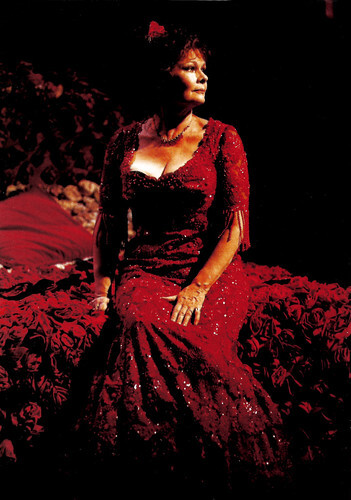
British postcard by Royal National Theatre, no. LNM 2. Photo: Michael Le Poer Trench. Judi Dench in 'A Little Night Music' (Olivier Theatre, 1995).
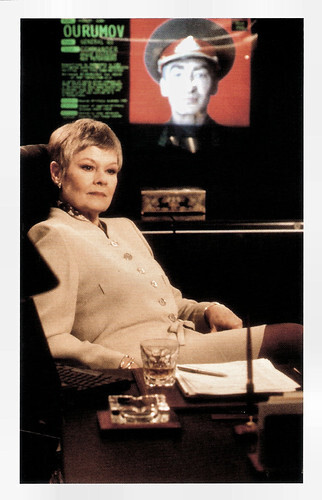
British postcard by Danjaq, LLC and United Artists Corporation. Photo: Judi Dench as M in GoldenEye (Martin Campbell, 1995). In the background, on the screen, Gottfried John as Colonel Ourumov.
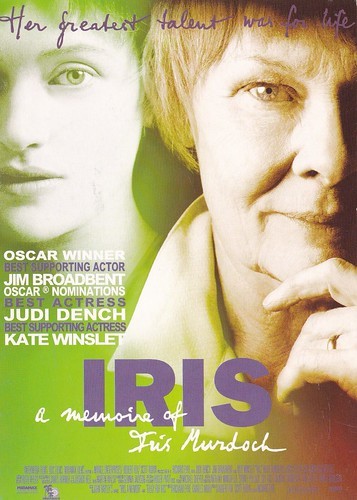
Dutch postcard by John v.d. Burg Indoor Media. Image: French poster for Iris (Richard Eyre, 2001) with Judi Dench and Kate Winslet . Caption: A Memoir of Iris Murdoch. Collection: Carla Bosch (Meiter).
Sources: Wikipedia (Dutch and English) and .

British postcard and photo by Robert Workman, Theatrical Photographer. Caption: Dame Judi Dench, Actress.

Chinese postcard by Oriental City Publishing Group Limited. Judi Dench as M in Quantum of Solace (Marc Forster, 2008).
Most Promising Newcomer
Dame Judith Olivia Dench was born in Heworth, York, in 1934. Dench was the daughter of Eleanora Olive (born Jones) and Reginald Arthur Dench of Dorset, a doctor and an amateur actor. She has a younger brother Jeffrey, an actor and an older brother Peter, a doctor. She grew up a Quaker and lived in Tyldesley, Greater Manchester.
When Dench was thirteen she went to The Mount School in York. Her original ambition was to be a designer and she trained as a costume designer. At 23, she made her professional debut as Ophelia in 'Hamlet' in Liverpool in 1957. That same year, she made her debut in the Old Vic.
Although most of Dench's work during this early period was in theatre, she also branched out into film work and won a BAFTA Award as Most Promising Newcomer. In 1968, she drew excellent reviews for her leading role as Sally Bowles in the musical 'Cabaret'. Through the years, she performed with the Royal Shakespeare Company, the National Theatre, and at Old Vic Theatre, and played virtually most of Shakespeare's leading ladies.
For her stage work, she won many awards including the 1982 London Critics' Circle Theatre Award for 'A Kind of Alaska' and 'The Importance of Being Earnest', the 1996 Laurence Olivier Theatre Award for 'A Little Night Music' and the 1999 Tony Award for Best Broadway Actress in 'Amy's View'. In 1971, she married British actor Michael Williams, with whom she had a child, actress Tara Cressida 'Finty' Williams.
Dench and Michael Williams starred in many plays and TV shows together, including Bob Larby's sitcom, A Fine Romance (1981-1984). She is a ten-time BAFTA winner including Best Actress in a Comedy Series for A Fine Romance (1981), Best Supporting Actress in A Room with a View (James Ivory, 1985) and A Handful of Dust (1988). She also received an ACE award for her performance in the television series Mr & Mrs Edgehill (1985).

British postcard in the Royal Shakespeare Theatre series, no. 86. Photo: Joe Cocks. Judi Dench as Hermione in 'The Winter's Tale' by William Shakespeare, Stratford-upon-Avon, 1969.

British postcard by Royal National Theatre, no. NT 55. Photo: Mark Douet. Judi Dench in 'The Sea' (1991) by Edward Bond (Lyttelton Theatre, 1991).
The first female M
Judi Dench became best known to the general public for her role of M in the James Bond films, which she played from GoldenEye (Martin Campbell, 1995) with Pierce Brosnan through Skyfall (Sam Mendes, 2012) starring Daniel Craig , where M lost her life after a siege of Skyfall, James Bond's parents' castle.
She was the first woman to portray the character. Judi Dench became known for playing dignified, strong-willed women in positions of authority, who are sometimes opposed or criticised by those under them. She won her first Oscar nomination for Mrs Brown (John Madden, 1996). It was her breakthrough as a film actress. In 1999, she won the Oscar for Best Female Supporting Actress in Shakespeare in Love (John Madden, 1998). It was for a six-minute performance in only four scenes as Queen Elizabeth I.
Following her Oscar win, the producers of the Bond franchise gave her character M a much larger role, central to the film's plot, for the first time in the Bond franchise. While M had typically only been seen in Bond films in bookend scenes at the very beginning and end, this time around the writers made her past actions the primary motive for the film's two main villains.
Her other Oscar-nominated roles are Chocolat (Lasse Hallström, 2000) with Juliette Binoche , Iris (Richard Eyre, 2001) with Kate Winslet , Mrs Henderson Presents (Stephen Frears, 2005) with Bob Hoskins, Notes on a Scandal (Richard Eyre, 2006) with Cate Blanchett , Philomena (Stephen Frears, 2013) with Steve Coogan, and Belfast (Kenneth Branagh, 2021).
In May 2024, Dench announced that she would stop acting as she had gone virtually blind due to the eye disease macular degeneration. In 2022, she played her last film role in the American comedy Spirited (Sean Anders, 2022) starring Will Ferrell and Ryan Reynolds. In 1997, she became a grandmother at age 62 when her daughter Finty Williams gave birth to a son, Sam Michael Williams. Michael Williams died in 2001 at the age of 66. Since 2010, her partner is David Mills.

British postcard by Royal National Theatre, no. LNM 2. Photo: Michael Le Poer Trench. Judi Dench in 'A Little Night Music' (Olivier Theatre, 1995).

British postcard by Danjaq, LLC and United Artists Corporation. Photo: Judi Dench as M in GoldenEye (Martin Campbell, 1995). In the background, on the screen, Gottfried John as Colonel Ourumov.

Dutch postcard by John v.d. Burg Indoor Media. Image: French poster for Iris (Richard Eyre, 2001) with Judi Dench and Kate Winslet . Caption: A Memoir of Iris Murdoch. Collection: Carla Bosch (Meiter).
Sources: Wikipedia (Dutch and English) and .
Published on February 23, 2025 22:00
February 22, 2025
Virna Lisi
The seductive Italian actress Virna Lisi (1936-2014) appeared in more than 100 film and TV productions and is internationally best known as a tempting blue-eyed blonde in Hollywood productions of the 1960s. But she proved to be more than a pretty face. From the late 1970s, she had a career renaissance with three-dimensional character parts in a wide variety of Italian and French films. A triumph was her portrayal of a malevolent Catherine de Medici in La Reine Margot (1994) for which she won both the David di Donatello and the César award.
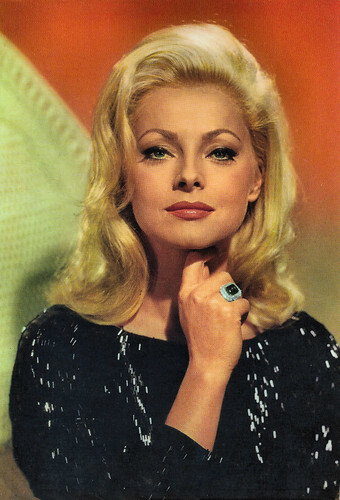
Italian postcard by Rotalcolor / Rotalfoto, no. 242.
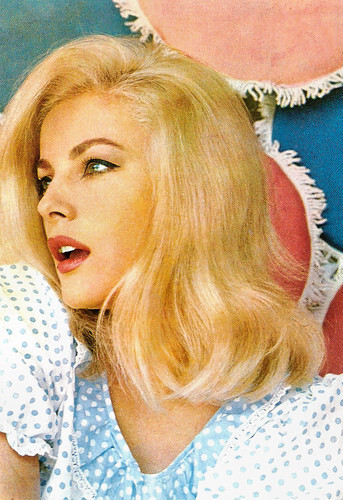
Italian postcard.
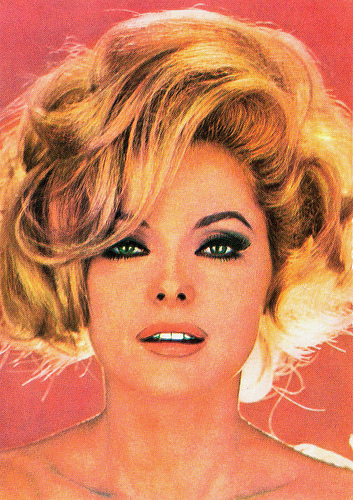
Romanian postcard by Casa Filmului Acin. Retail price: 2 Lei.
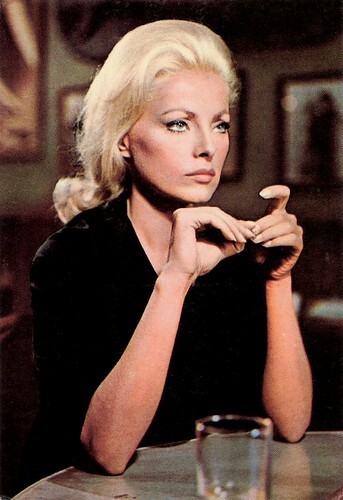
Italian postcard. Photo: Paramount. Publicity still for Assault on a Queen (Jack Donohue, 1966).
With such a mouth...
Virna Lisi was born as Virna Lisa Pieralisi in Ancona, Italy in 1936. Her father had a marble exporting business on the Adriatic coast. Her brother, Ubaldo Pieralisi, later became a talent agent, and her sister Esperia Pieralisi also became an actress.
Virna began her film career as a teenager. She was discovered by two Neapolitan producers, Antonio Ferrigno and Ettore Pesce, in Paris. Her debut was in La corda d'acciaio/The Line of Steel (Carlo Borghesio, 1953-1958). Initially, she did musical films, like E Napoli canta/Napoli Sings (Armando Grottini, 1953) and the successful four-episode film Questa è la vita/Such is Life (Luigi Zampa a.o., 1954), with the popular comedian Totò .
Her looks were more valued than her talent in some of her early films, like in Le diciottenni/Eighteen Year Olds (Mario Mattoli, 1955) with Marisa Allasio , and Lo scapolo/The Bachelor (Antonio Pietrangeli, 1955) with Alberto Sordi .
She played more demanding roles in Il cardinale Lambertini/Cardinal Lambertini (Giorgio Pastina, 1954) opposite Gino Cervi , La Donna del Giorno/The Doll That Took the Town (Francesco Maselli, 1956), the Peplum Romolo e Remo/Duel of the Titans (Sergio Corbucci, 1961) featuring musclemen Steve Reeves and Gordon Scott as the two legendary brothers Romulus and Remus, and Eva/Eve (Joseph Losey, 1962) starring Jeanne Moreau .
In the late 1950s, Lisi played on stage at the Piccolo Teatro di Milano and appeared in 'I giacobini' by Federico Zardi, under the direction of Giorgio Strehler. During the 1960s, she performed in stage comedies and she also participated in some very popular television dramas. On TV she also promoted a toothpaste brand, with a slogan which would become a catchphrase amongst the Italians: "con quella bocca può dire ciò che vuole" (with such a mouth, she can say whatever she wants).
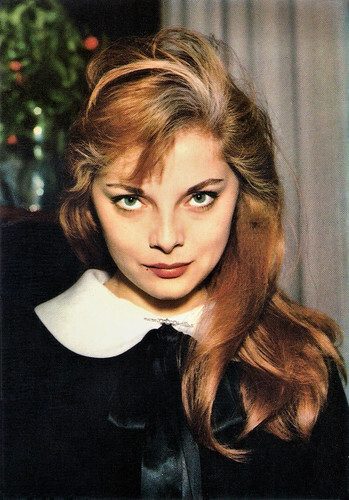
Italian postcard by Rotalcolor / Rotalfoto, Milano, no. N 63.

Italian postcard by Rotalcolor, Milano, no. 660.
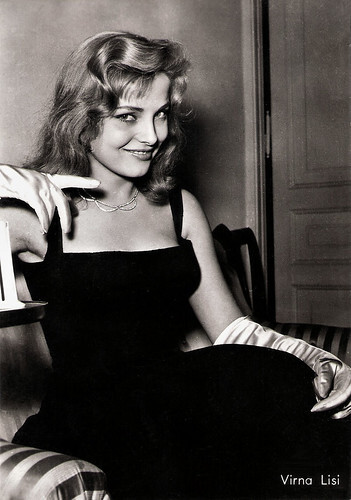
Italian postcard by Bromostampa, Milano, no. 148.
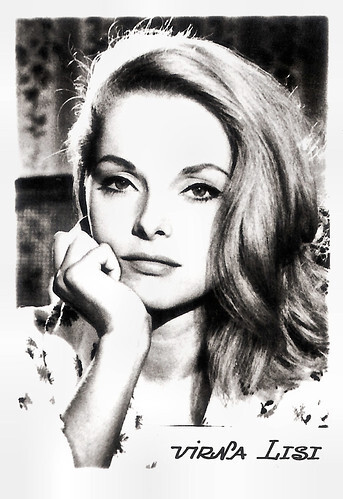
Romanian collector card.
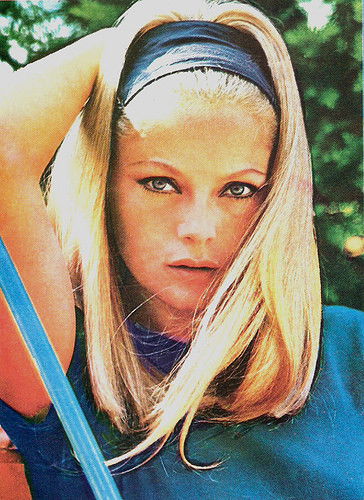
Yugoslavian postcard by Cik Razglednica.
Tempting blue-eyed blonde
In France, Virna Lisi played the role that brought her first international attention, in La tulipe noire/The Black Tulip (Christian-Jacque, 1964). As the heroine to Alain Delon ’s dashing Swashbuckler, she combined sexiness with dexterity. In the 1960s, Hollywood producers were looking for a successor to Marilyn Monroe and so Lisi then made a dent in Hollywood comedies as a tempting blue-eyed blonde.
She first starred opposite Jack Lemmon in George Axelrod’s satirical How to Murder Your Wife (Richard Quine, 1965). At IMDb , reviewer Mdantonio loves her performance: “What most everyone fails to mention in the comments is the incredible skill of Virna Lisi. She is a natural mixing it up with Lemmon, (Claire) Trevor and the other veterans like she had been making movies for years. I have watched many movies in my day and I must say that Virna Lisi is right at the top, not only in beauty and sexuality but in carrying her role as good as anyone else could have. Ms. Lisi, my hat is off to you.” Lisi also gained attention with the March 1965 cover of Esquire magazine on which she was shaving her face. The following year she appeared in another comedy, Not with My Wife, You Don't! (Norman Panama, 1966) now with Tony Curtis .
She also starred with Frank Sinatra in Assault on a Queen (Jack Donohue, 1966), with Rod Steiger in La Ragazza e il Generale/The Girl and the General (Pasquale Festa Campanile, 1967), and twice with Anthony Quinn , in the war drama La vingt-cinquième heure/The 25th Hour (Henri Verneuil, 1967), and in The Secret of Santa Vittoria (Stanley Kramer, 1969). John Francis Lane in his obituary in The Guardian : "Though she enjoyed her American experiences and appreciated the professionalism she encountered, Lisi soon tired of the 'new Marilyn' image foisted upon her. She accepted becoming a cover girl but refused a lucrative offer to pose for Playboy."
To overcome her typecasting as a sexy, seductive woman, Lisi sought new types of roles and found these in such Italian comedies as Le bambole/Four Kinds of Love (Dino Risi a.o., 1965), Signore & signori/The Birds, the Bees and the Italians (Pietro Germi, 1966) and Le dolci signore/Anyone Can Play (Fausto Saraceni, Luigi Zampa, 1968), and Roma bene (Carlo Lizzani, 1971) with Senta Berger .
At AllMovie , Robert Firsching reviewed Signore & signori: “Pietro Germi's funny anthology combines the standard sex comedy format with some unexpectedly subtle observations about village life. The film centres on three stories exposing the sexual secrets of the Italian town of Treviso. (...) Signore e Signori won the Best Film award at the 1966 Cannes Film Festival.”
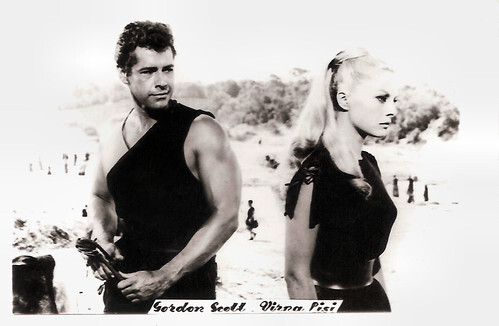
Small Romanian collector card. Photo: publicity still for Romolo e Remo/Duel of the Titans (Sergio Corbucci, 1961) with Gordon Scott .
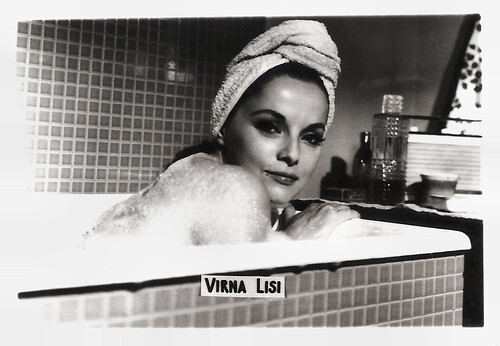
Small Romanian collector card.
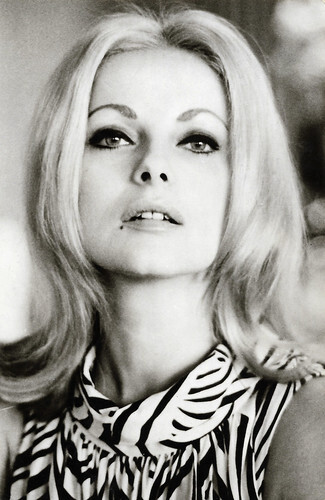
Romanian postcard by Casa Filmului Acin, no. 565.
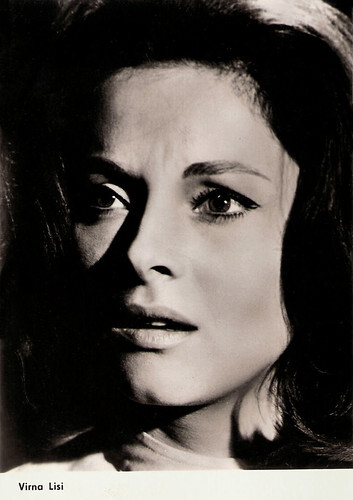
East German postcard by VEB Progress Film-Vertrieb, no. 2.624, 1966. Virna Lisi in Les bonnes causes/Don't Tempt the Devil (Christian-Jaque, 1963).

East-German postcard by VEB Progress Filmvertrieb, Berlin, no. 2481, 1965. Photo: publicity still for La tulipe noire/The Black Tulip (Christian-Jacque, 1964) with Alain Delon and Virna Lisi.
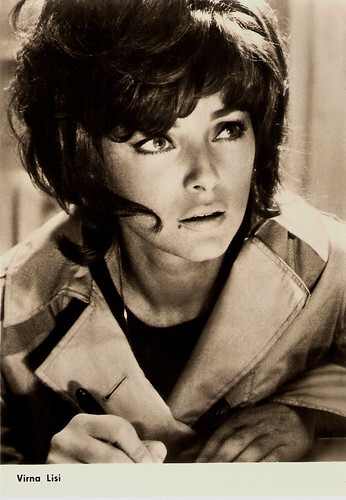
East-German postcard by VEB Progress Film-Vertrieb, Berlin, no. 2869. Retail price: 0,20 MDN.
Career renaissance
In the early 1970s, Virna Lisi decided to focus on her family, her husband Franco Pesci and her son Corrado, born in 1962. In the later 1970s, she had a career renaissance with a series of major Italian films. She played Friedrich Nietzsche’s neurotic sister, Elisabeth, in the controversial Al di là del bene e del male/Beyond Good and Evil (Liliana Cavani, 1977) starring Dominique Sanda .
It was followed by roles in Ernesto (Salvatore Samperi, 1979), La cicala/The Cricket (Alberto Lattuada, 1980), and I ragazzi di via Panisperna/The Boys of the Via Panisperna (Gianni Amelio, 1989) with Andrea Prodan and Mario Adorf . Andrea Prodan’s brother Luca Prodan is the singer of the Argentinean band Sumo which made a song for Lisi. The Brazilian rock band Virna Lisi is even named after her.
Her greatest triumph was the French film La Reine Margot/Queen Margot (Patrice Chéreau, 1994) in which Lisi played a malevolent Catherine de Medici, ordering assaults, poisonings, and instigations to incest. Karl Williams at AllMovie : “The historical novel by Alexandre Dumas was adapted for the screen with this lavish French epic, winner of 5 Césars and a pair of awards at the Cannes Film Festival. Isabelle Adjani stars as Marguerite de Valois, better known as Margot, daughter of scheming Catholic power player Catherine de Medici (Virna Lisi).” For her magnificent portrayal, Lisi won the César and the Best Actress award at Cannes, and also the David di Donatello award, the Italian equivalent of the Oscar.
In the new century, she did many successful dramatic TV productions, including L'onore e il rispetto/Honour and Respect (Salvatore Samperi, 2006) with Gabriel Garko and Giancarlo Giannini. In 2002, Lisi starred in Il più bel giorno della mia vita/The Best Day of My Life (Cristina Comencini, 2002) with Margherita Buy, and she reunited with director Cristina Comencini for her final film, the comedy Latin Lover ().
In 1960, Virna Lisi married architect Franco Pesci, who died in 2013. A year later, Lisi passed away at the age of 78. She was survived by her son Corrado and three grandchildren: Franco, Federico and Riccardo. Italian media quoted Corrado as saying that Lisi had passed away peacefully in her sleep, a month after being diagnosed with an incurable illness.
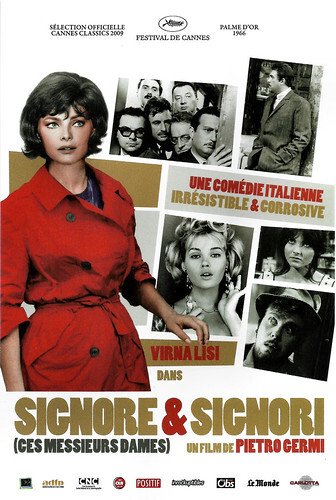
French postcard by Dark Star. Image: French poster for the 2009 re-issue of Signore & Signori (Pietro Germi, 1966) with Virna Lisi.
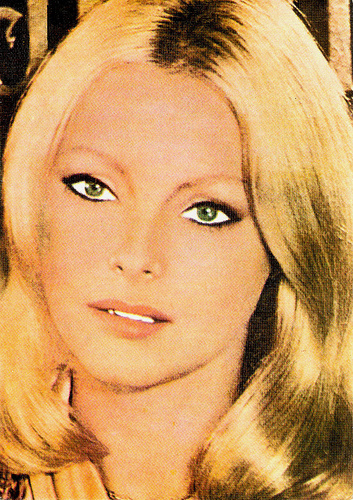
Romanian postcard by Casa Filmului Acin, no. 43078.
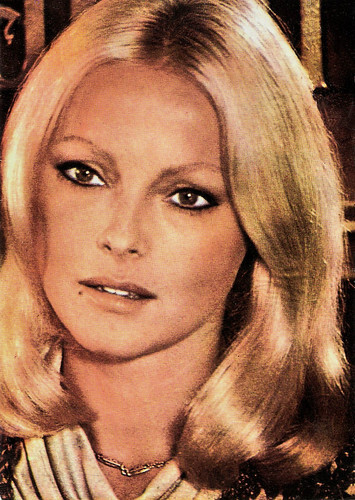
Romanian postcard by Casa Filmului Acin, no. 561.
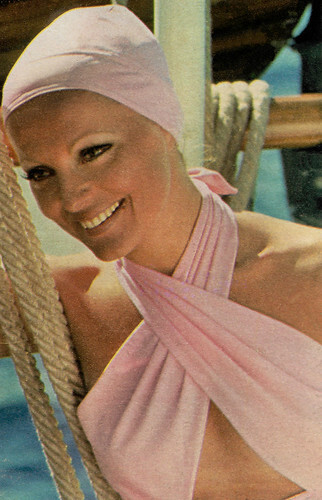
French postcard by Ch. Bergeret, Strasbourg.
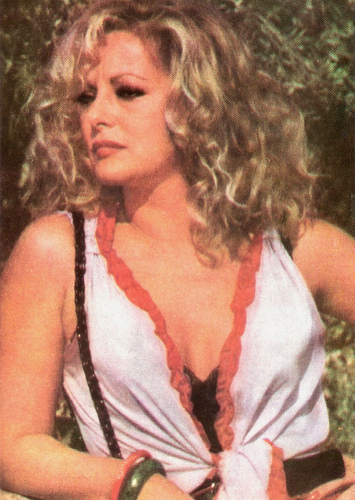
Romanian postcard by Casa Filmului Acin.
Trailer of La Reine Margot/Queen Margot (Patrice Chéreau, 1994). Source: mearbhrach (YouTube).
Sources: John Francis Lane (The Guardian), Hal Erickson (AllMovie - Page now defunct), Robert Firsching (AllMovie - Page now defunct), Karl Williams (AllMovie - Page now defunct), (IMDb), Glamour Girls of the Silver Screen, Wikipedia and .

Italian postcard by Rotalcolor / Rotalfoto, no. 242.

Italian postcard.

Romanian postcard by Casa Filmului Acin. Retail price: 2 Lei.

Italian postcard. Photo: Paramount. Publicity still for Assault on a Queen (Jack Donohue, 1966).
With such a mouth...
Virna Lisi was born as Virna Lisa Pieralisi in Ancona, Italy in 1936. Her father had a marble exporting business on the Adriatic coast. Her brother, Ubaldo Pieralisi, later became a talent agent, and her sister Esperia Pieralisi also became an actress.
Virna began her film career as a teenager. She was discovered by two Neapolitan producers, Antonio Ferrigno and Ettore Pesce, in Paris. Her debut was in La corda d'acciaio/The Line of Steel (Carlo Borghesio, 1953-1958). Initially, she did musical films, like E Napoli canta/Napoli Sings (Armando Grottini, 1953) and the successful four-episode film Questa è la vita/Such is Life (Luigi Zampa a.o., 1954), with the popular comedian Totò .
Her looks were more valued than her talent in some of her early films, like in Le diciottenni/Eighteen Year Olds (Mario Mattoli, 1955) with Marisa Allasio , and Lo scapolo/The Bachelor (Antonio Pietrangeli, 1955) with Alberto Sordi .
She played more demanding roles in Il cardinale Lambertini/Cardinal Lambertini (Giorgio Pastina, 1954) opposite Gino Cervi , La Donna del Giorno/The Doll That Took the Town (Francesco Maselli, 1956), the Peplum Romolo e Remo/Duel of the Titans (Sergio Corbucci, 1961) featuring musclemen Steve Reeves and Gordon Scott as the two legendary brothers Romulus and Remus, and Eva/Eve (Joseph Losey, 1962) starring Jeanne Moreau .
In the late 1950s, Lisi played on stage at the Piccolo Teatro di Milano and appeared in 'I giacobini' by Federico Zardi, under the direction of Giorgio Strehler. During the 1960s, she performed in stage comedies and she also participated in some very popular television dramas. On TV she also promoted a toothpaste brand, with a slogan which would become a catchphrase amongst the Italians: "con quella bocca può dire ciò che vuole" (with such a mouth, she can say whatever she wants).

Italian postcard by Rotalcolor / Rotalfoto, Milano, no. N 63.

Italian postcard by Rotalcolor, Milano, no. 660.

Italian postcard by Bromostampa, Milano, no. 148.

Romanian collector card.

Yugoslavian postcard by Cik Razglednica.
Tempting blue-eyed blonde
In France, Virna Lisi played the role that brought her first international attention, in La tulipe noire/The Black Tulip (Christian-Jacque, 1964). As the heroine to Alain Delon ’s dashing Swashbuckler, she combined sexiness with dexterity. In the 1960s, Hollywood producers were looking for a successor to Marilyn Monroe and so Lisi then made a dent in Hollywood comedies as a tempting blue-eyed blonde.
She first starred opposite Jack Lemmon in George Axelrod’s satirical How to Murder Your Wife (Richard Quine, 1965). At IMDb , reviewer Mdantonio loves her performance: “What most everyone fails to mention in the comments is the incredible skill of Virna Lisi. She is a natural mixing it up with Lemmon, (Claire) Trevor and the other veterans like she had been making movies for years. I have watched many movies in my day and I must say that Virna Lisi is right at the top, not only in beauty and sexuality but in carrying her role as good as anyone else could have. Ms. Lisi, my hat is off to you.” Lisi also gained attention with the March 1965 cover of Esquire magazine on which she was shaving her face. The following year she appeared in another comedy, Not with My Wife, You Don't! (Norman Panama, 1966) now with Tony Curtis .
She also starred with Frank Sinatra in Assault on a Queen (Jack Donohue, 1966), with Rod Steiger in La Ragazza e il Generale/The Girl and the General (Pasquale Festa Campanile, 1967), and twice with Anthony Quinn , in the war drama La vingt-cinquième heure/The 25th Hour (Henri Verneuil, 1967), and in The Secret of Santa Vittoria (Stanley Kramer, 1969). John Francis Lane in his obituary in The Guardian : "Though she enjoyed her American experiences and appreciated the professionalism she encountered, Lisi soon tired of the 'new Marilyn' image foisted upon her. She accepted becoming a cover girl but refused a lucrative offer to pose for Playboy."
To overcome her typecasting as a sexy, seductive woman, Lisi sought new types of roles and found these in such Italian comedies as Le bambole/Four Kinds of Love (Dino Risi a.o., 1965), Signore & signori/The Birds, the Bees and the Italians (Pietro Germi, 1966) and Le dolci signore/Anyone Can Play (Fausto Saraceni, Luigi Zampa, 1968), and Roma bene (Carlo Lizzani, 1971) with Senta Berger .
At AllMovie , Robert Firsching reviewed Signore & signori: “Pietro Germi's funny anthology combines the standard sex comedy format with some unexpectedly subtle observations about village life. The film centres on three stories exposing the sexual secrets of the Italian town of Treviso. (...) Signore e Signori won the Best Film award at the 1966 Cannes Film Festival.”

Small Romanian collector card. Photo: publicity still for Romolo e Remo/Duel of the Titans (Sergio Corbucci, 1961) with Gordon Scott .

Small Romanian collector card.

Romanian postcard by Casa Filmului Acin, no. 565.

East German postcard by VEB Progress Film-Vertrieb, no. 2.624, 1966. Virna Lisi in Les bonnes causes/Don't Tempt the Devil (Christian-Jaque, 1963).

East-German postcard by VEB Progress Filmvertrieb, Berlin, no. 2481, 1965. Photo: publicity still for La tulipe noire/The Black Tulip (Christian-Jacque, 1964) with Alain Delon and Virna Lisi.

East-German postcard by VEB Progress Film-Vertrieb, Berlin, no. 2869. Retail price: 0,20 MDN.
Career renaissance
In the early 1970s, Virna Lisi decided to focus on her family, her husband Franco Pesci and her son Corrado, born in 1962. In the later 1970s, she had a career renaissance with a series of major Italian films. She played Friedrich Nietzsche’s neurotic sister, Elisabeth, in the controversial Al di là del bene e del male/Beyond Good and Evil (Liliana Cavani, 1977) starring Dominique Sanda .
It was followed by roles in Ernesto (Salvatore Samperi, 1979), La cicala/The Cricket (Alberto Lattuada, 1980), and I ragazzi di via Panisperna/The Boys of the Via Panisperna (Gianni Amelio, 1989) with Andrea Prodan and Mario Adorf . Andrea Prodan’s brother Luca Prodan is the singer of the Argentinean band Sumo which made a song for Lisi. The Brazilian rock band Virna Lisi is even named after her.
Her greatest triumph was the French film La Reine Margot/Queen Margot (Patrice Chéreau, 1994) in which Lisi played a malevolent Catherine de Medici, ordering assaults, poisonings, and instigations to incest. Karl Williams at AllMovie : “The historical novel by Alexandre Dumas was adapted for the screen with this lavish French epic, winner of 5 Césars and a pair of awards at the Cannes Film Festival. Isabelle Adjani stars as Marguerite de Valois, better known as Margot, daughter of scheming Catholic power player Catherine de Medici (Virna Lisi).” For her magnificent portrayal, Lisi won the César and the Best Actress award at Cannes, and also the David di Donatello award, the Italian equivalent of the Oscar.
In the new century, she did many successful dramatic TV productions, including L'onore e il rispetto/Honour and Respect (Salvatore Samperi, 2006) with Gabriel Garko and Giancarlo Giannini. In 2002, Lisi starred in Il più bel giorno della mia vita/The Best Day of My Life (Cristina Comencini, 2002) with Margherita Buy, and she reunited with director Cristina Comencini for her final film, the comedy Latin Lover ().
In 1960, Virna Lisi married architect Franco Pesci, who died in 2013. A year later, Lisi passed away at the age of 78. She was survived by her son Corrado and three grandchildren: Franco, Federico and Riccardo. Italian media quoted Corrado as saying that Lisi had passed away peacefully in her sleep, a month after being diagnosed with an incurable illness.

French postcard by Dark Star. Image: French poster for the 2009 re-issue of Signore & Signori (Pietro Germi, 1966) with Virna Lisi.

Romanian postcard by Casa Filmului Acin, no. 43078.

Romanian postcard by Casa Filmului Acin, no. 561.

French postcard by Ch. Bergeret, Strasbourg.

Romanian postcard by Casa Filmului Acin.
Trailer of La Reine Margot/Queen Margot (Patrice Chéreau, 1994). Source: mearbhrach (YouTube).
Sources: John Francis Lane (The Guardian), Hal Erickson (AllMovie - Page now defunct), Robert Firsching (AllMovie - Page now defunct), Karl Williams (AllMovie - Page now defunct), (IMDb), Glamour Girls of the Silver Screen, Wikipedia and .
Published on February 22, 2025 22:00
February 21, 2025
Chariklia Baxevanos
Swiss actress Chariklia Baxevanos (1936) has appeared in more than sixty films since 1952.
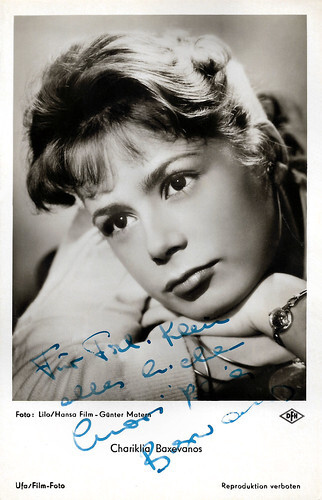
West German postcard by Ufa/Film-Foto, Berlin-Tempelhof, no. FK 3776. Photo: Lilo / Hansa Film / Günter Matern. Chariklia Baxevanos in Von allen geliebt / Of All Loved (Paul Verhoeven, 1957).
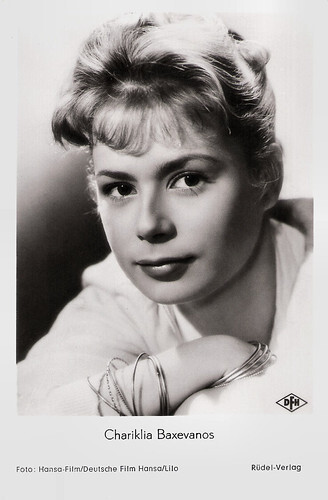
West German postcard by Rüdel-Verlag, Hamburg-Bergedorf, no. 2173. Photo: Hansa Film / Deutsche Film Hansa / Lilo. Chariklia Baxevanos in Von allen geliebt/Of All Loved (Paul Verhoeven, 1957).
A versatile and promising talent
Chariklia Baxevanos was born in 1936 to Greek parents in Zurich. Her father was the operatic tenor Peter Baxevanos, who later sang at the Volksoper in Vienna, and was a theatre director in Athens.
Chariklia grew up in Vienna, attending the gymnasium ‘Sacré Coeur’. Helene Thimig , Max Reinhardt 's widow, convinced her parents of their daughter's talent and invited her to study acting at the Max Reinhardt Seminar in Vienna. She studied for two years at the Max-Reinhardt Seminar and graduated there with distinction in 1953.
She had her first success in the same year with ‘Gigi’ at the Wiesbaden State Theatre. Her ‘Mamsell Nitouche’ at the Munich Kammerspiele was her second major stage success.
Since then, several major theatres engaged the versatile and promising actress. For eight years she played at the Theater in der Josefstadt in Vienna. Among others, she played the title role in Terence Rattigan's ‘The Prince and the Dancer’. She was ‘Leonore’ at the Zurich Schauspielhaus, and played in Henrik Ibsen's ‘Wildente’ (The Wild Duck) and Jean Anouilh's ‘Leocadia’.
On the German stage (latterly at Berlin's Theater am Kurfürstendamm under the direction of her then-husband Christian Wölffer), Chariklia Baxevanos headlined as Eliza Doolittle, Anne Frank, Bernadette of Lourdes, Irma La Douce and Rosalinde in William Shakespeare's 'As You Like It'.
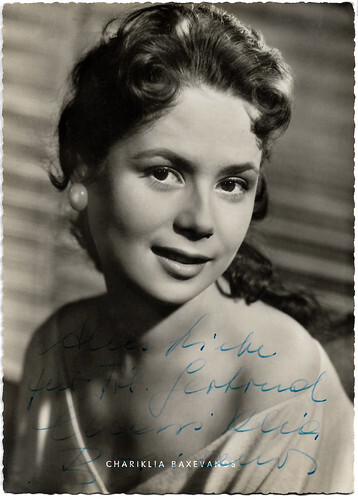
West German postcard by Irma-Verlag, Stuttgart-W. Photo: Arthur Grimm / CCC-Film / Herzog-Film. Sent by mail in 1958.
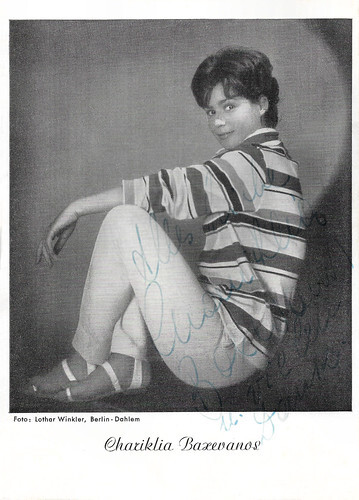
West German autograph card. Photo: Lothar Winkler, Berlin-Dahlem.
Schlager and holiday films
At the age of 16, Chariklia Baxevanos made her film debut in a small role in in the Austrian comedy Schäm' dich, Brigitte! / Shame on You, Brigitte! (E.W. Emo, 1952), starring Heinz Rühmann , Theo Lingen and Hans Moser . She played the younger sister of Mozart's wife Constanze ( Gertrüd Kückelmann ) in the biopic Mozart (Karl Hartl, 1955), starring Oskar Werner .
In the 1950s, she was frequently seen in Schlager and holiday films, such as Musikparade / Music Parade (Géza von Cziffra, 1956) with Georg Thomalla and Peter Alexander and Ein Stück vom Himmel / A Piece of Heaven (Rudolf Jugert, 1957) with Toni Sailer. She played the leading role alongside Joachim Fuchsberger in Eva küßt nur Direktoren / Eva Kisses Only Directors (Rudolf Jugert, 1957). In her last outing on the big screen, she provided comic relief, in the Edgar Wallace adaptation of Das Ungeheuer von London-City / The Monster of London City (Edwin Zbonek, 1964) with Hans-Jörg Felmy .
Better known on television, she starred as the eponymous heroine of the short-lived drama series Wilhelmina (Thomas Engel, 1968) with Brigitte Mira . She made guest appearances in several episodes of the Science Fiction series Unterwegs nach Atlantis / On the Way to Atlantis (Thomas Fantl, 1982) in addition to a memorable performance in the all-star, Francis Durbridge inspired Mini Series Verräter / Traitor (Michael Braun, 1967).
As a voice actress, she provided the German dubbing for, among others, Carole Landis, Shirley MacLaine , Madeline Kahn and Virna Lisi . 'Baxi' was married twice. Her first husband was the actor Horst Frank, remembered as one of the great European screen villains of the era. He is the father of their daughter Désirée. They divorced a year later.
She then had a ten-year-long relationship with actor Harald Juhnke. They never married and parted ways in 1971, presumably as a consequence of Juhnke's problems with alcoholism. Her second husband was the stage director, writer and actor Christian Wölffer (1942-2015), co-owner, partner and part of the management team of the Berlin Theater am Kurfürstendamm. Her last film with him was the comedy Zwiebeln und Butterplätzchen / Onions and Butter Biscuits (Christian Woelffer, 1990) with Peer Schmidt and Elisabeth Volkmann.
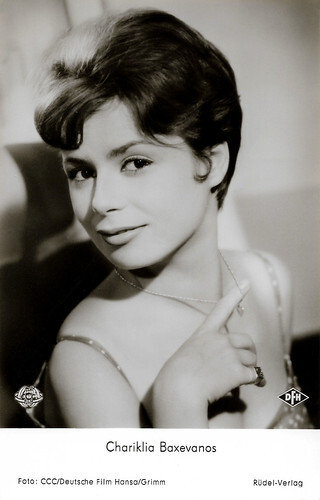
West German postcard by Rüdel Verlag, Hamburg-Bergedorf, no. 2867. Photo: CCC-Film / Deutsche Film Hansa / Arthur Grimm. Chariklia Baxevanos in Abschied von den Wolken/Rebel Flight to Cuba (Gottfried Reinhardt, 1959).
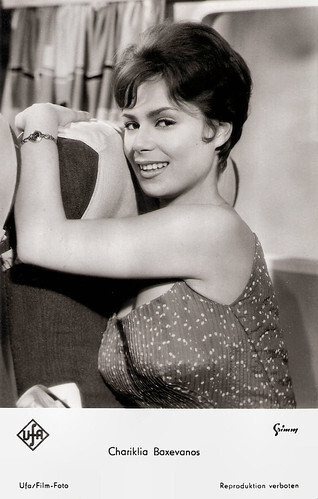
West German postcard by Ufa-Film-Foto, Berlin-Tempelhof, no. FK 4775. Photo: Arthur Grimm.
Sources: (IMDb), Munzinger (German), Wikipedia (English and German) and .

West German postcard by Ufa/Film-Foto, Berlin-Tempelhof, no. FK 3776. Photo: Lilo / Hansa Film / Günter Matern. Chariklia Baxevanos in Von allen geliebt / Of All Loved (Paul Verhoeven, 1957).

West German postcard by Rüdel-Verlag, Hamburg-Bergedorf, no. 2173. Photo: Hansa Film / Deutsche Film Hansa / Lilo. Chariklia Baxevanos in Von allen geliebt/Of All Loved (Paul Verhoeven, 1957).
A versatile and promising talent
Chariklia Baxevanos was born in 1936 to Greek parents in Zurich. Her father was the operatic tenor Peter Baxevanos, who later sang at the Volksoper in Vienna, and was a theatre director in Athens.
Chariklia grew up in Vienna, attending the gymnasium ‘Sacré Coeur’. Helene Thimig , Max Reinhardt 's widow, convinced her parents of their daughter's talent and invited her to study acting at the Max Reinhardt Seminar in Vienna. She studied for two years at the Max-Reinhardt Seminar and graduated there with distinction in 1953.
She had her first success in the same year with ‘Gigi’ at the Wiesbaden State Theatre. Her ‘Mamsell Nitouche’ at the Munich Kammerspiele was her second major stage success.
Since then, several major theatres engaged the versatile and promising actress. For eight years she played at the Theater in der Josefstadt in Vienna. Among others, she played the title role in Terence Rattigan's ‘The Prince and the Dancer’. She was ‘Leonore’ at the Zurich Schauspielhaus, and played in Henrik Ibsen's ‘Wildente’ (The Wild Duck) and Jean Anouilh's ‘Leocadia’.
On the German stage (latterly at Berlin's Theater am Kurfürstendamm under the direction of her then-husband Christian Wölffer), Chariklia Baxevanos headlined as Eliza Doolittle, Anne Frank, Bernadette of Lourdes, Irma La Douce and Rosalinde in William Shakespeare's 'As You Like It'.

West German postcard by Irma-Verlag, Stuttgart-W. Photo: Arthur Grimm / CCC-Film / Herzog-Film. Sent by mail in 1958.

West German autograph card. Photo: Lothar Winkler, Berlin-Dahlem.
Schlager and holiday films
At the age of 16, Chariklia Baxevanos made her film debut in a small role in in the Austrian comedy Schäm' dich, Brigitte! / Shame on You, Brigitte! (E.W. Emo, 1952), starring Heinz Rühmann , Theo Lingen and Hans Moser . She played the younger sister of Mozart's wife Constanze ( Gertrüd Kückelmann ) in the biopic Mozart (Karl Hartl, 1955), starring Oskar Werner .
In the 1950s, she was frequently seen in Schlager and holiday films, such as Musikparade / Music Parade (Géza von Cziffra, 1956) with Georg Thomalla and Peter Alexander and Ein Stück vom Himmel / A Piece of Heaven (Rudolf Jugert, 1957) with Toni Sailer. She played the leading role alongside Joachim Fuchsberger in Eva küßt nur Direktoren / Eva Kisses Only Directors (Rudolf Jugert, 1957). In her last outing on the big screen, she provided comic relief, in the Edgar Wallace adaptation of Das Ungeheuer von London-City / The Monster of London City (Edwin Zbonek, 1964) with Hans-Jörg Felmy .
Better known on television, she starred as the eponymous heroine of the short-lived drama series Wilhelmina (Thomas Engel, 1968) with Brigitte Mira . She made guest appearances in several episodes of the Science Fiction series Unterwegs nach Atlantis / On the Way to Atlantis (Thomas Fantl, 1982) in addition to a memorable performance in the all-star, Francis Durbridge inspired Mini Series Verräter / Traitor (Michael Braun, 1967).
As a voice actress, she provided the German dubbing for, among others, Carole Landis, Shirley MacLaine , Madeline Kahn and Virna Lisi . 'Baxi' was married twice. Her first husband was the actor Horst Frank, remembered as one of the great European screen villains of the era. He is the father of their daughter Désirée. They divorced a year later.
She then had a ten-year-long relationship with actor Harald Juhnke. They never married and parted ways in 1971, presumably as a consequence of Juhnke's problems with alcoholism. Her second husband was the stage director, writer and actor Christian Wölffer (1942-2015), co-owner, partner and part of the management team of the Berlin Theater am Kurfürstendamm. Her last film with him was the comedy Zwiebeln und Butterplätzchen / Onions and Butter Biscuits (Christian Woelffer, 1990) with Peer Schmidt and Elisabeth Volkmann.

West German postcard by Rüdel Verlag, Hamburg-Bergedorf, no. 2867. Photo: CCC-Film / Deutsche Film Hansa / Arthur Grimm. Chariklia Baxevanos in Abschied von den Wolken/Rebel Flight to Cuba (Gottfried Reinhardt, 1959).

West German postcard by Ufa-Film-Foto, Berlin-Tempelhof, no. FK 4775. Photo: Arthur Grimm.
Sources: (IMDb), Munzinger (German), Wikipedia (English and German) and .
Published on February 21, 2025 22:00
Paul van Yperen's Blog
- Paul van Yperen's profile
- 13 followers
Paul van Yperen isn't a Goodreads Author
(yet),
but they
do have a blog,
so here are some recent posts imported from
their feed.



